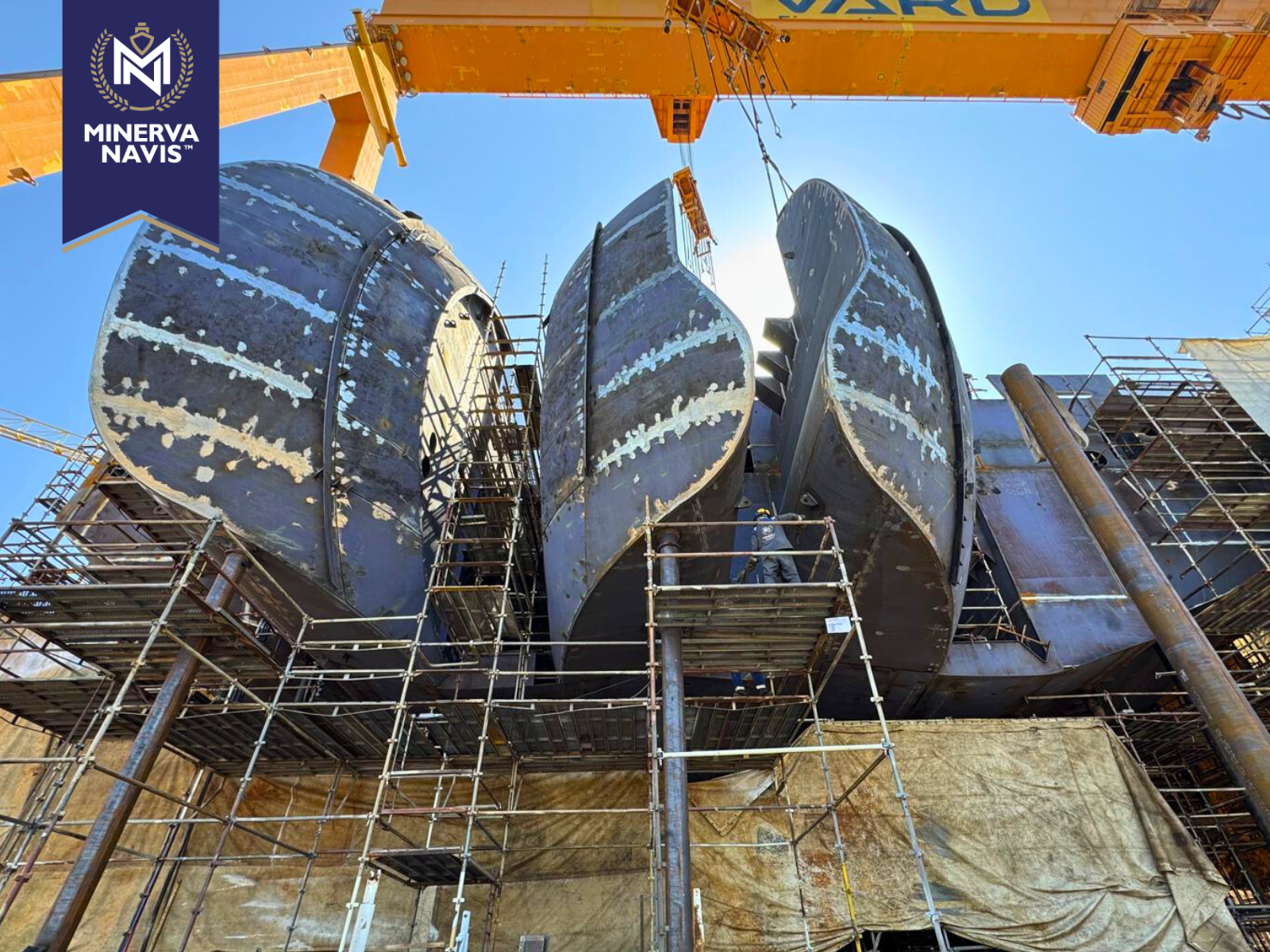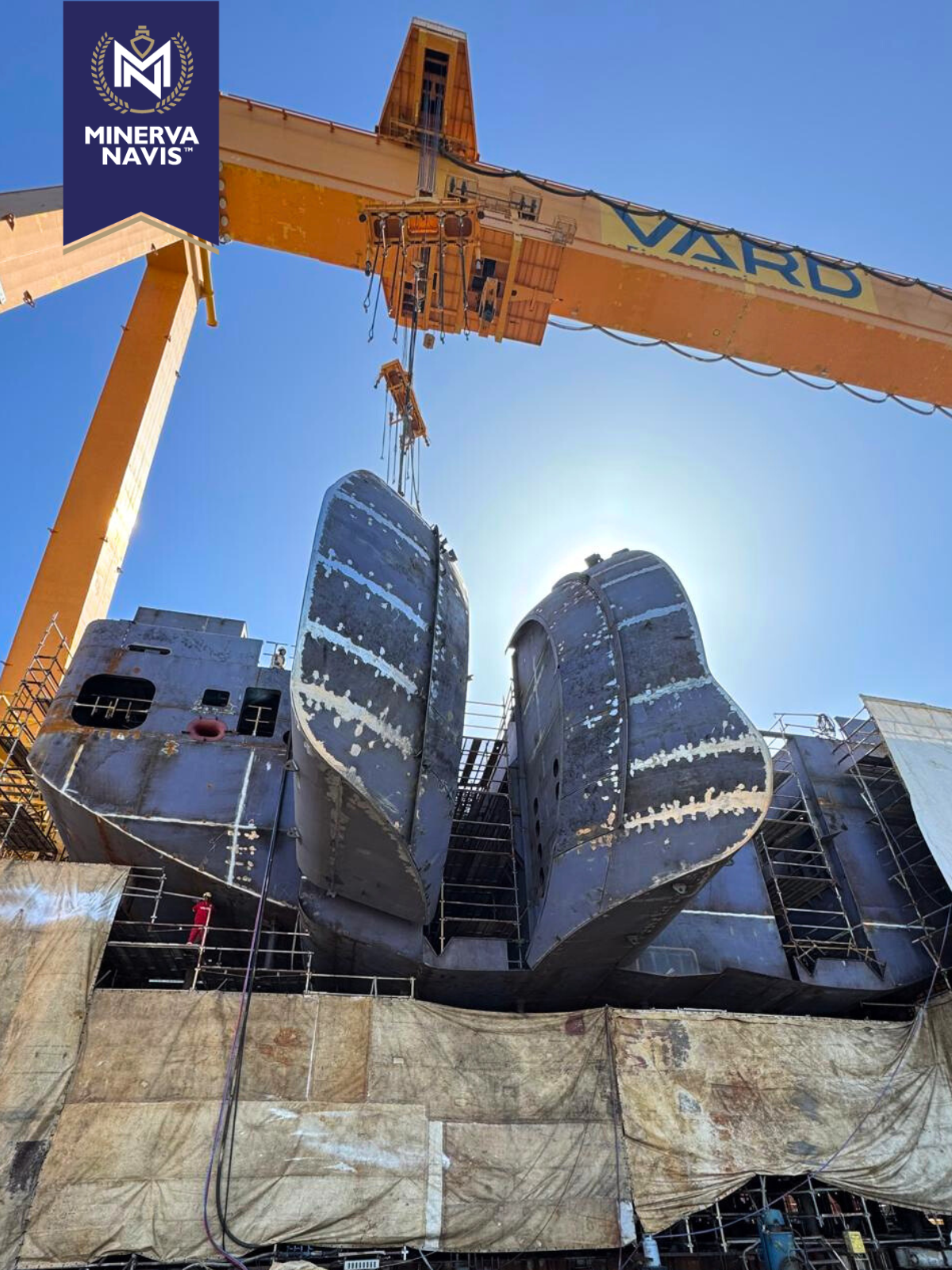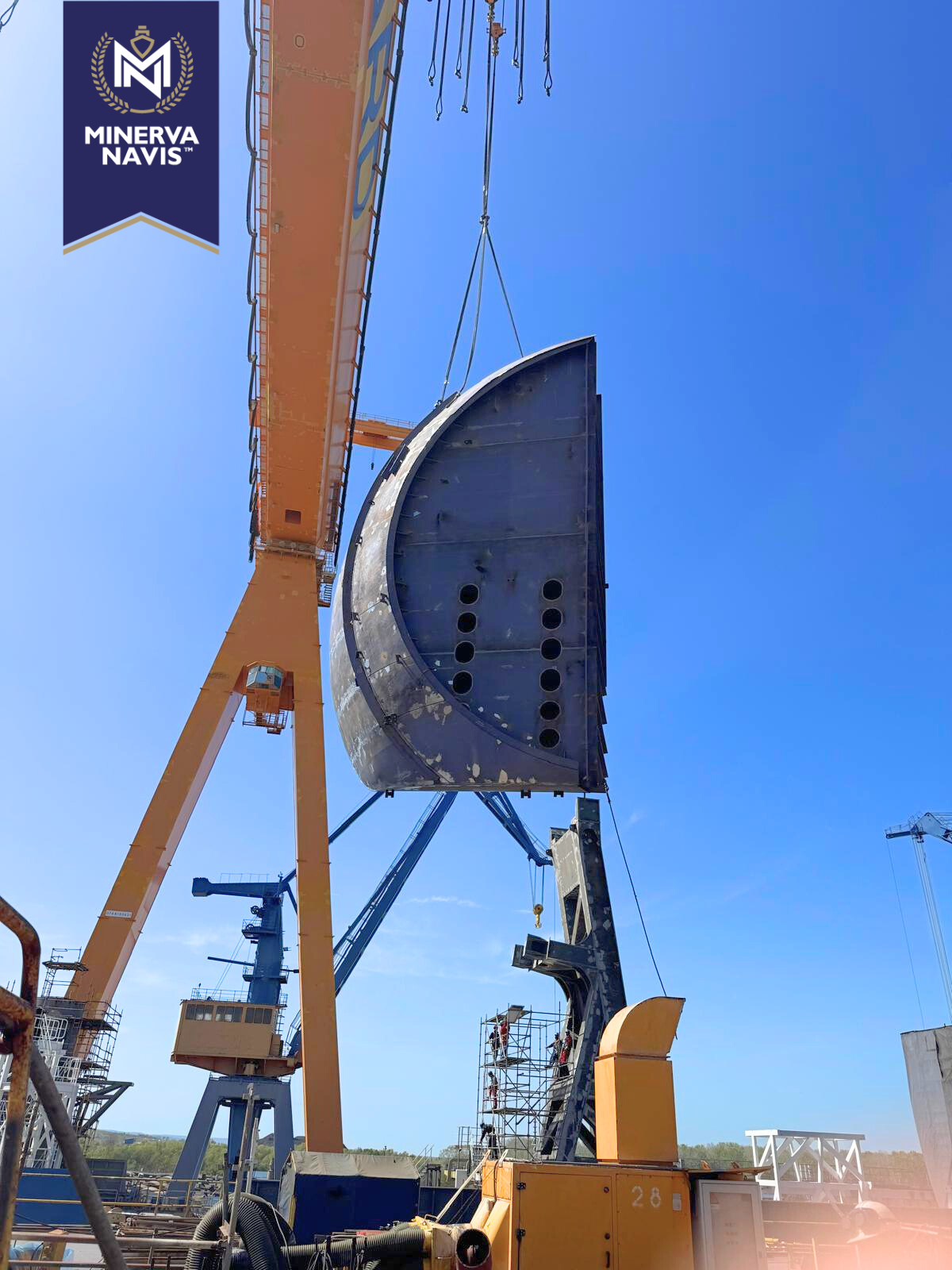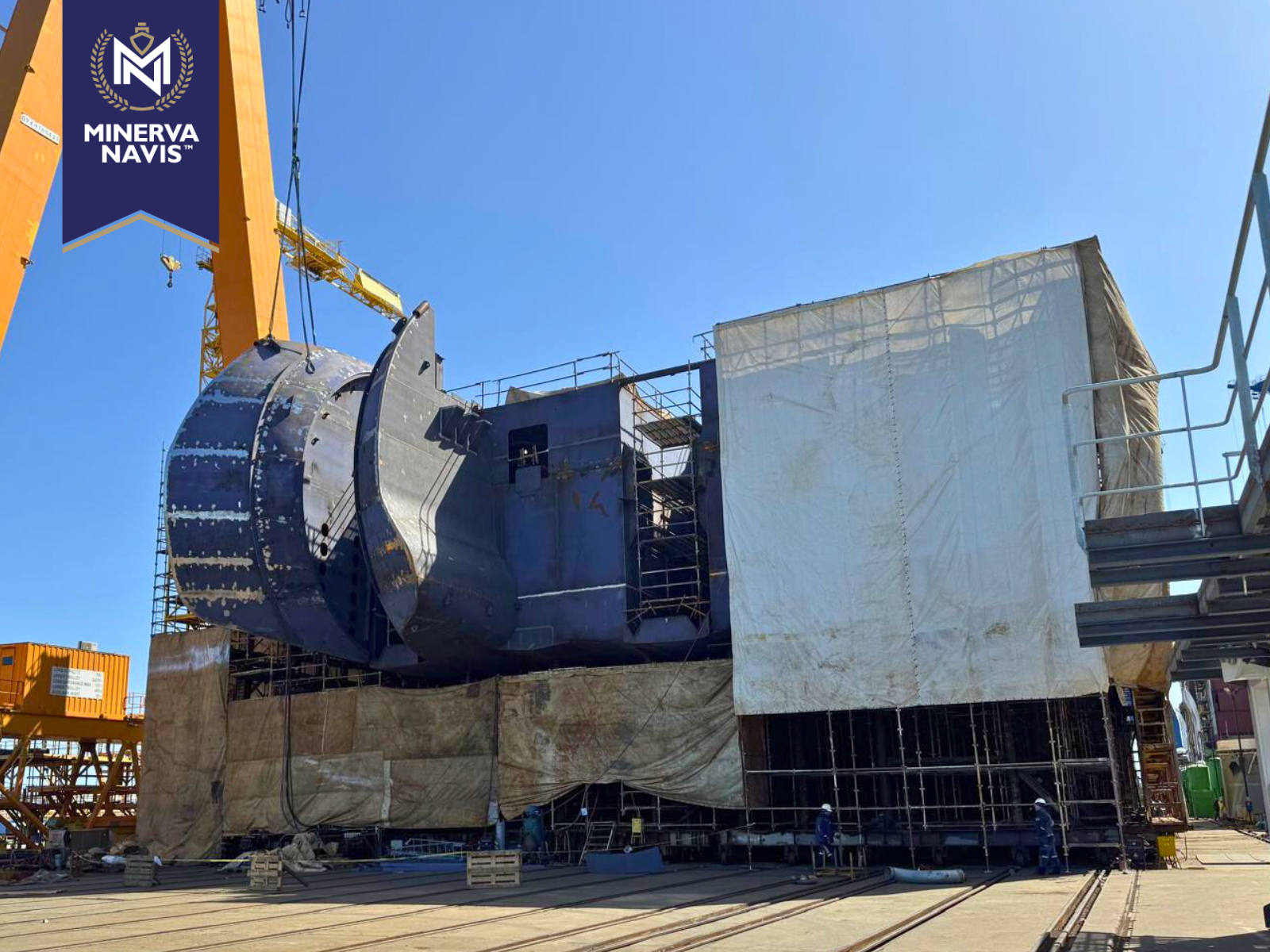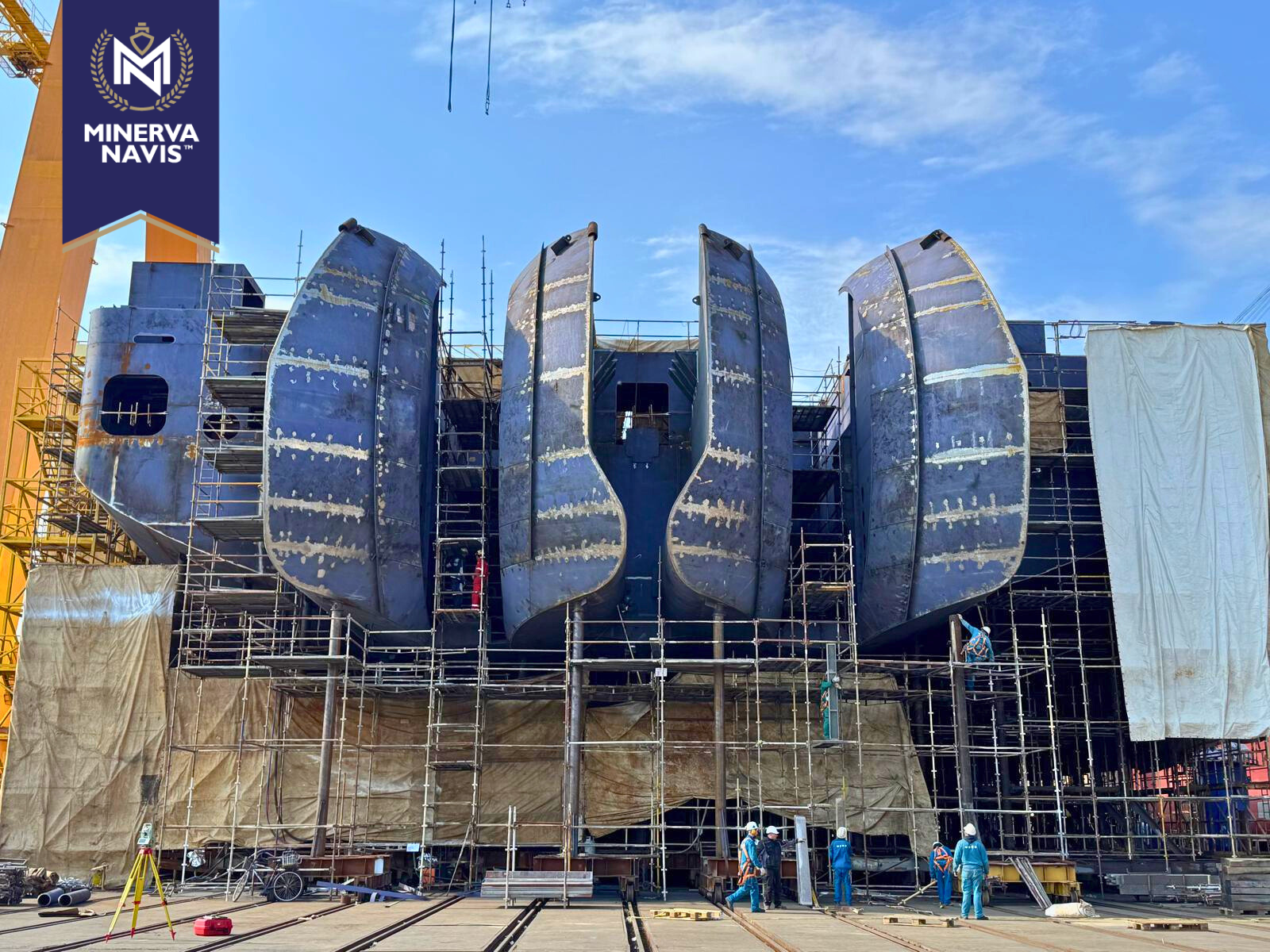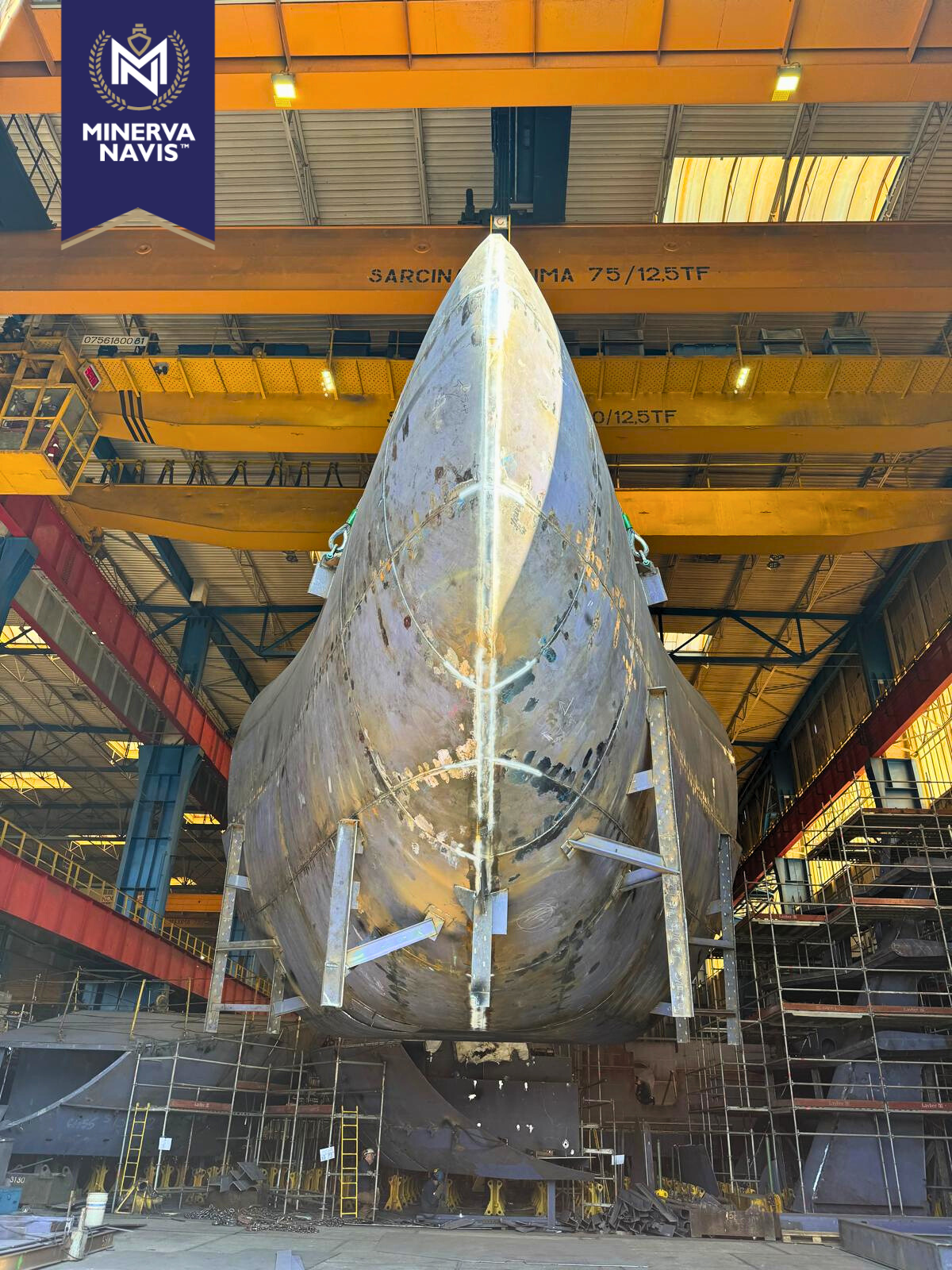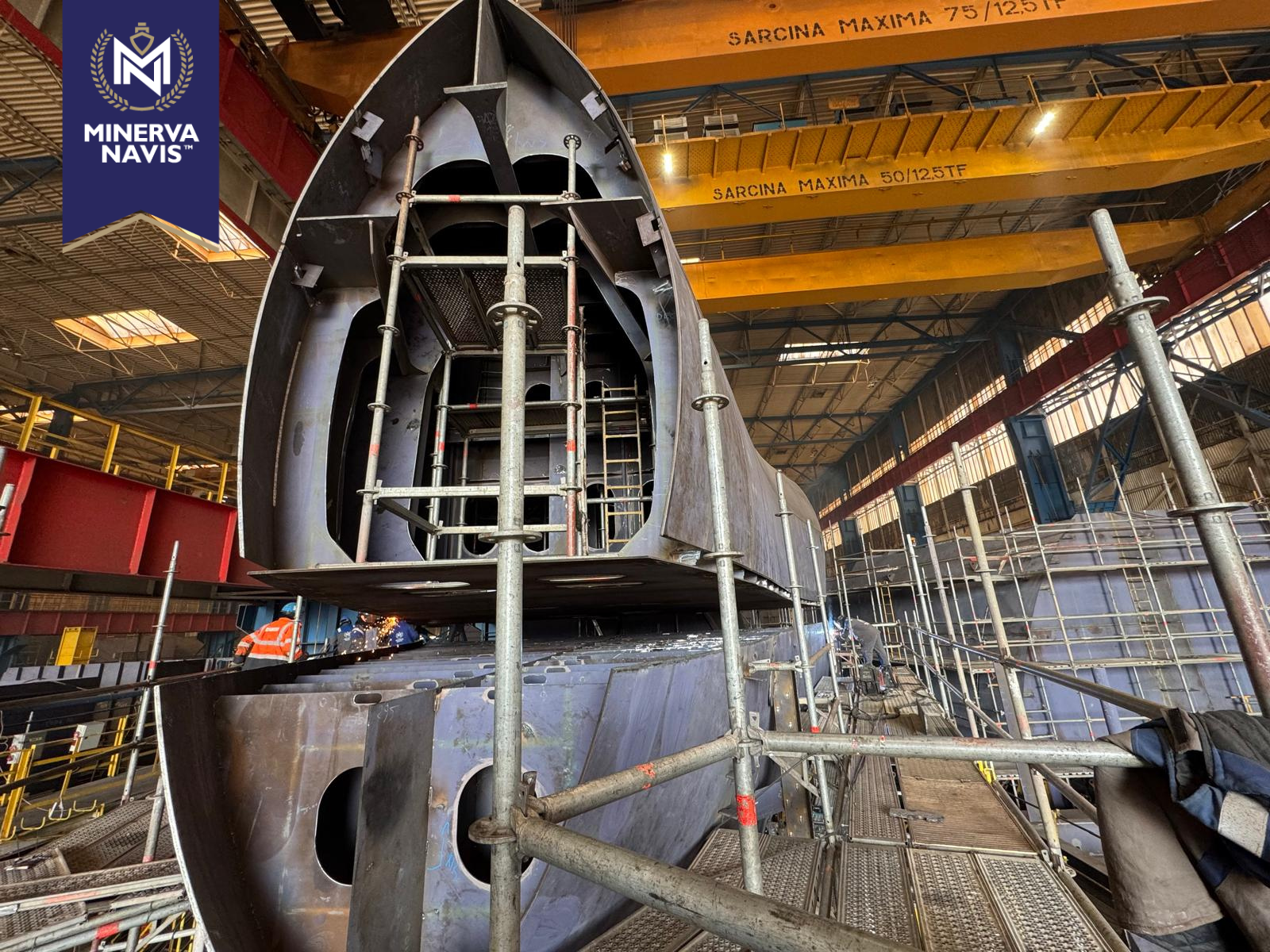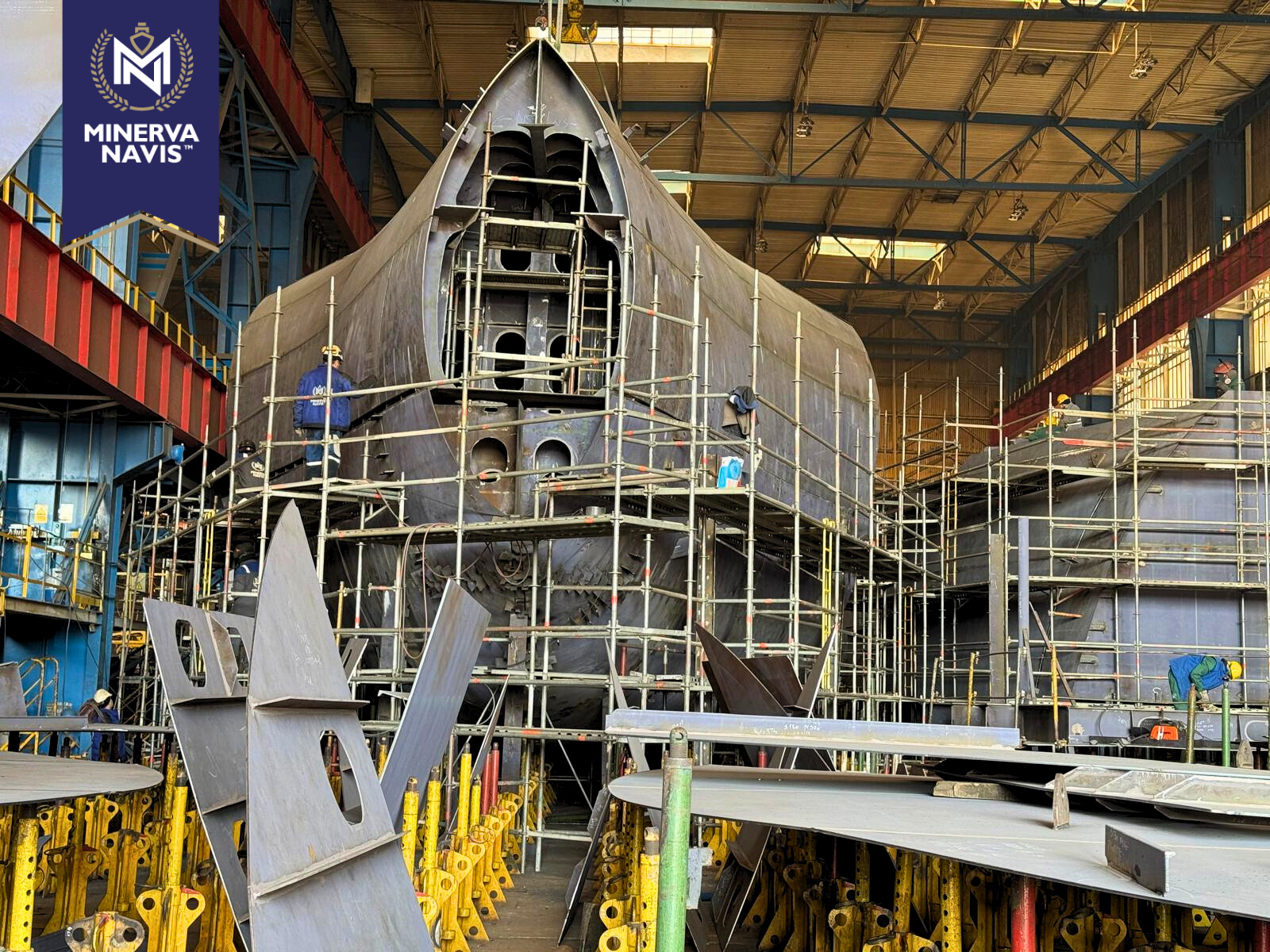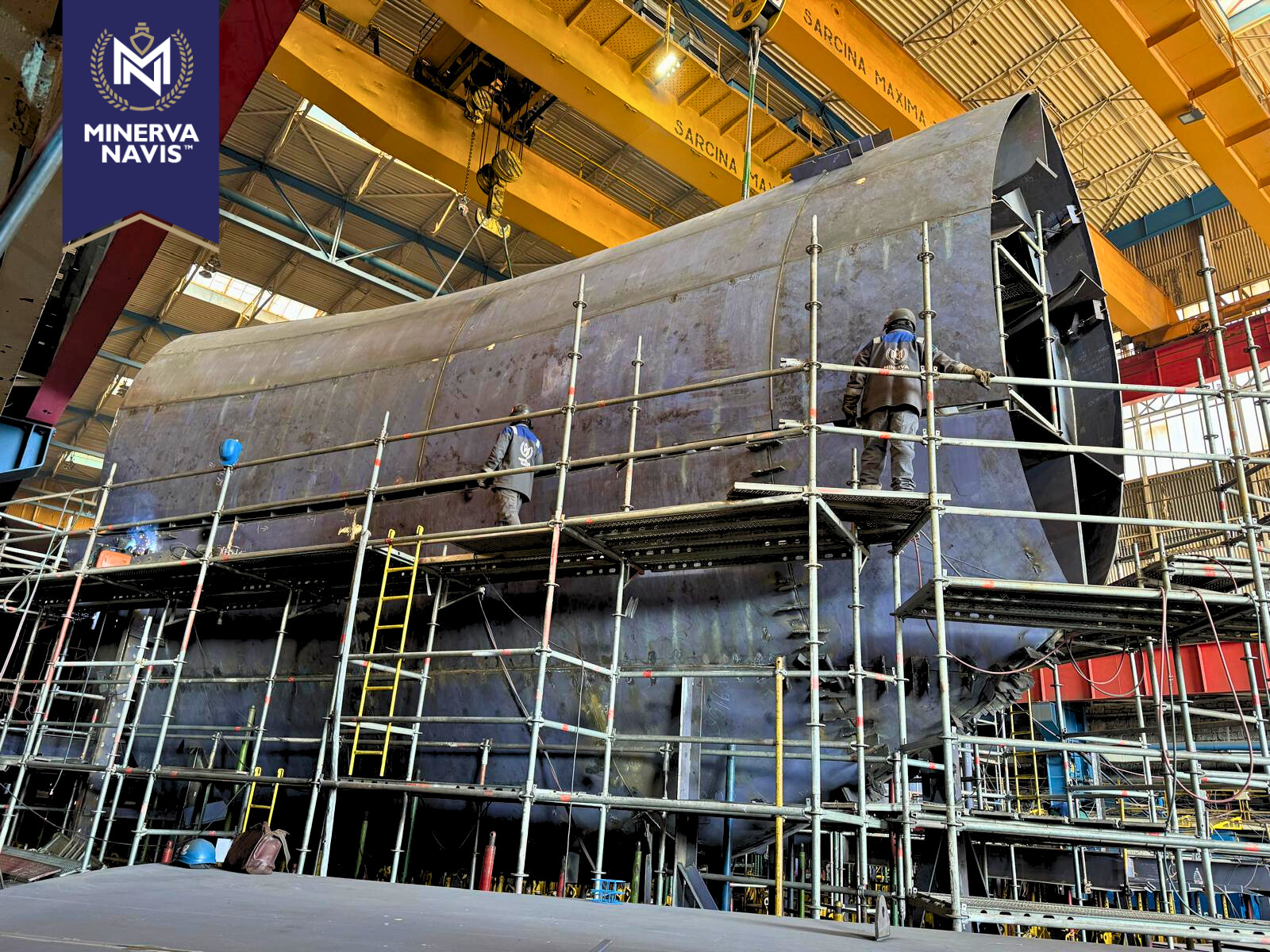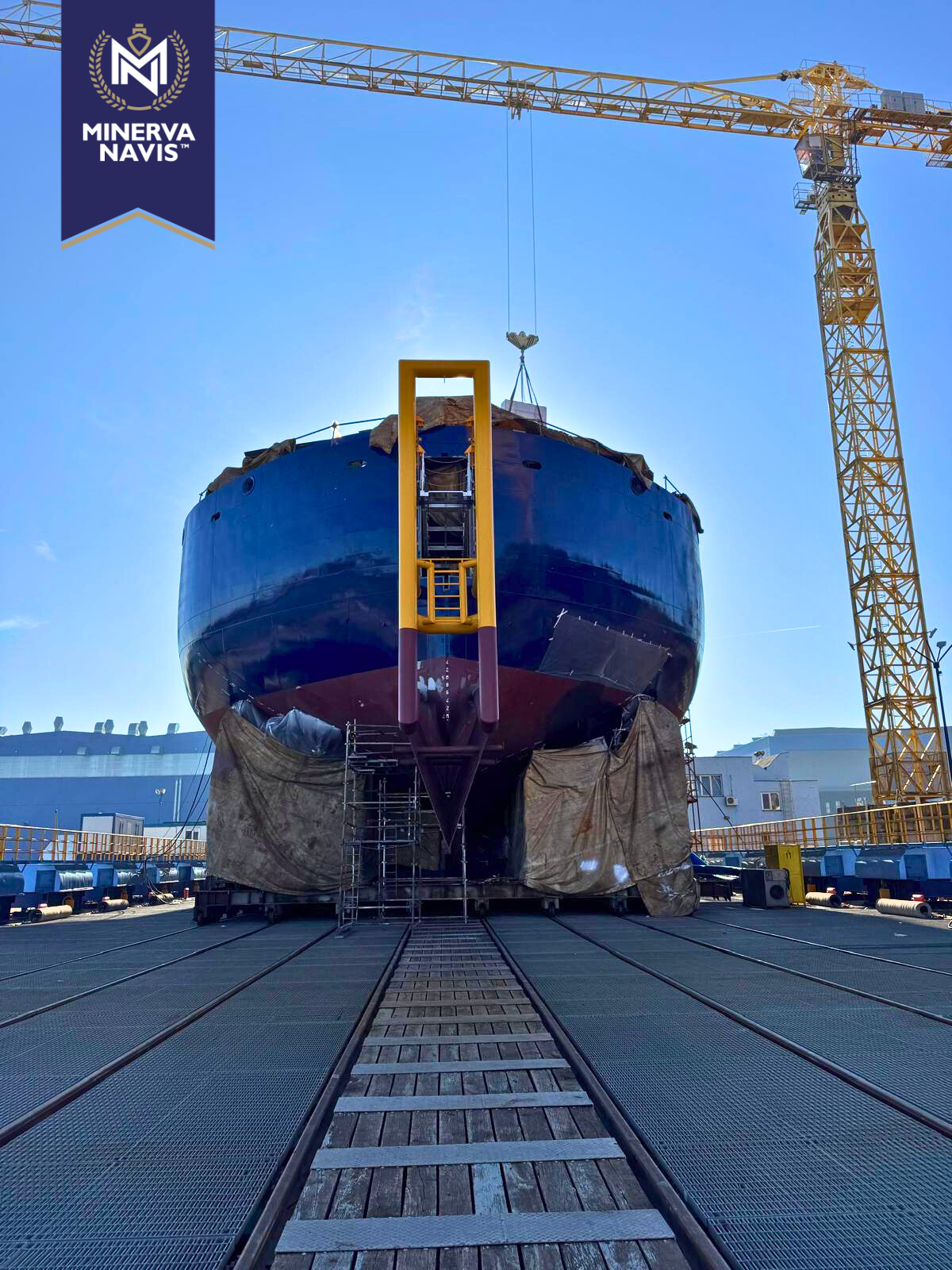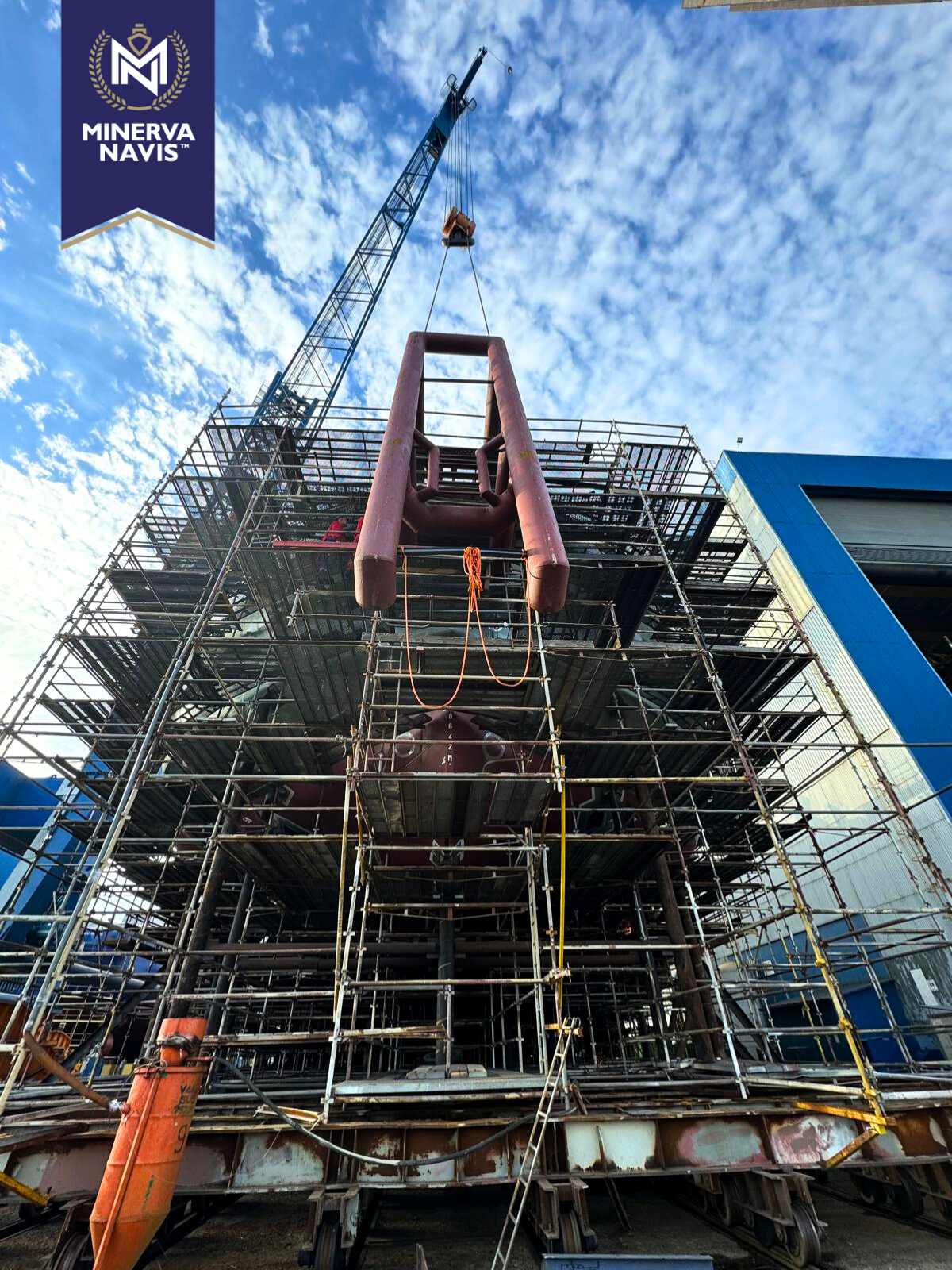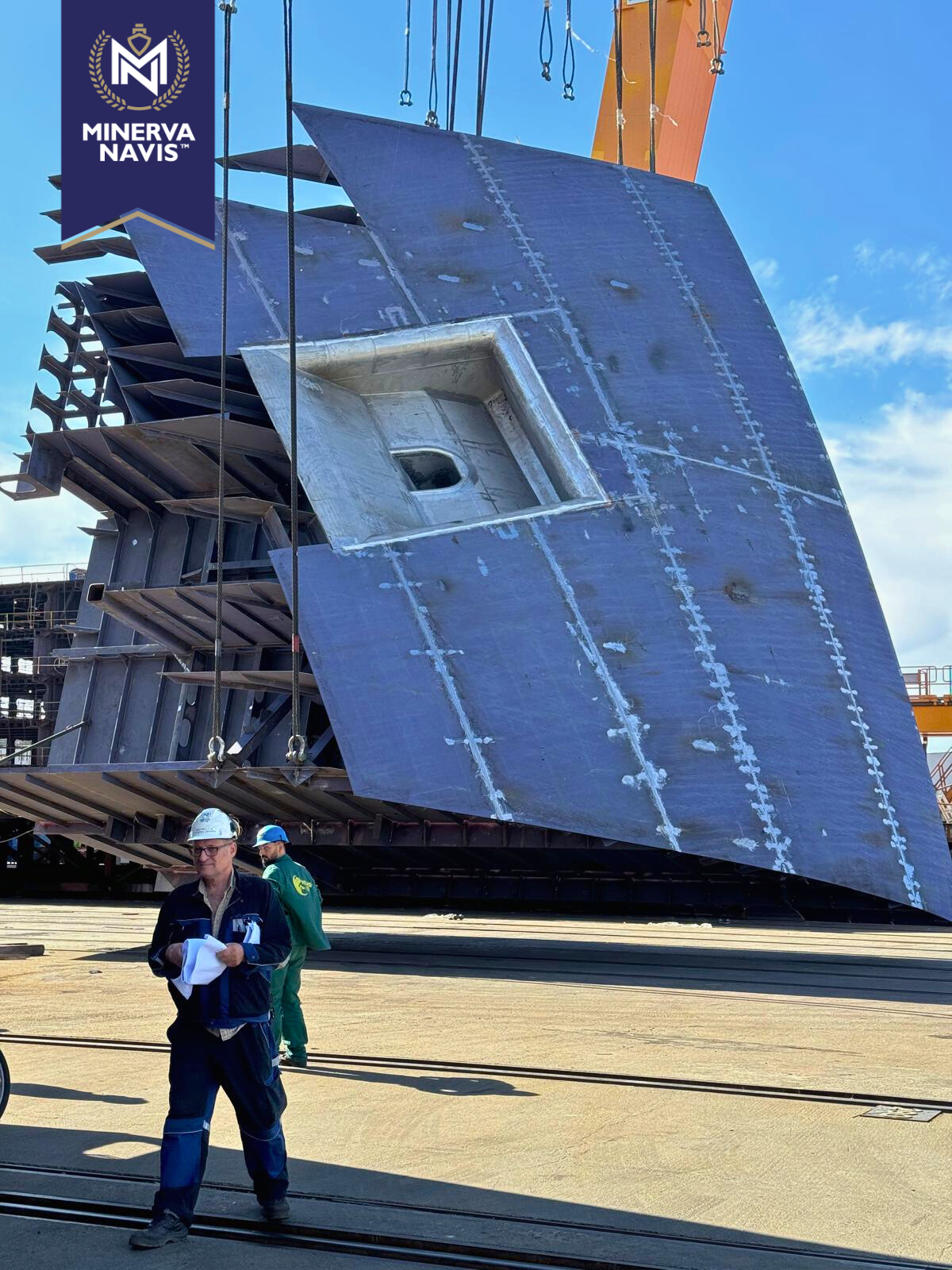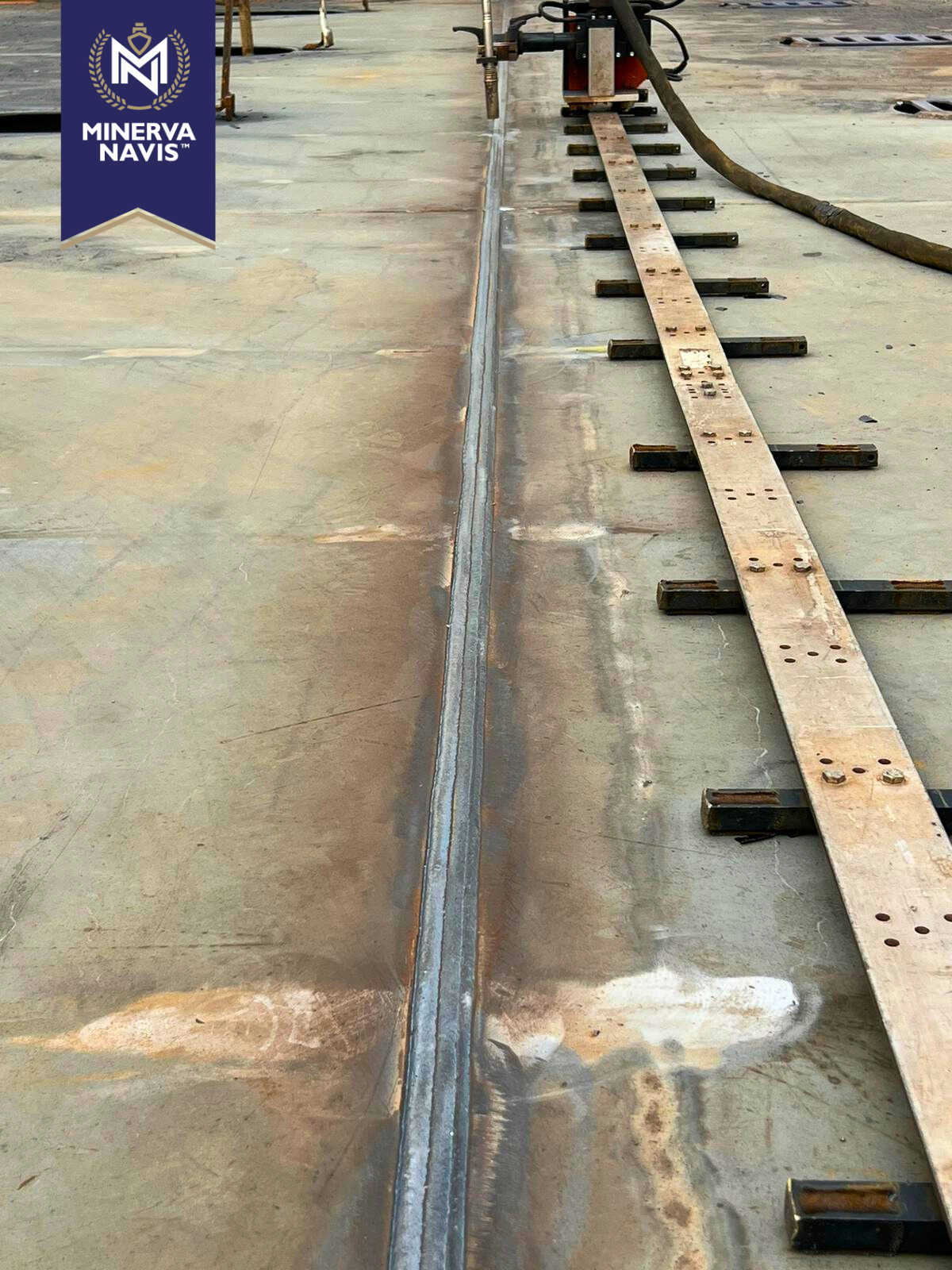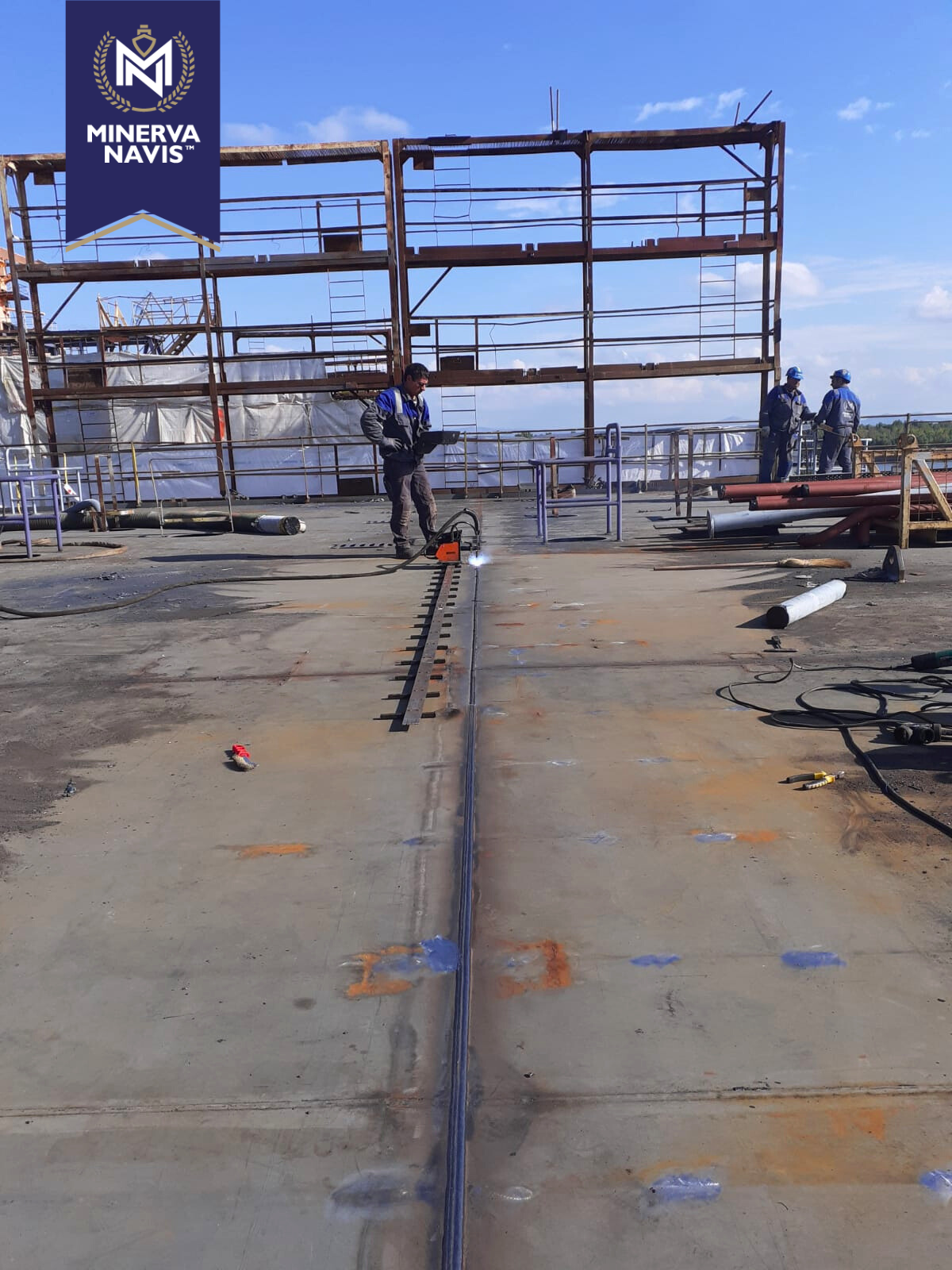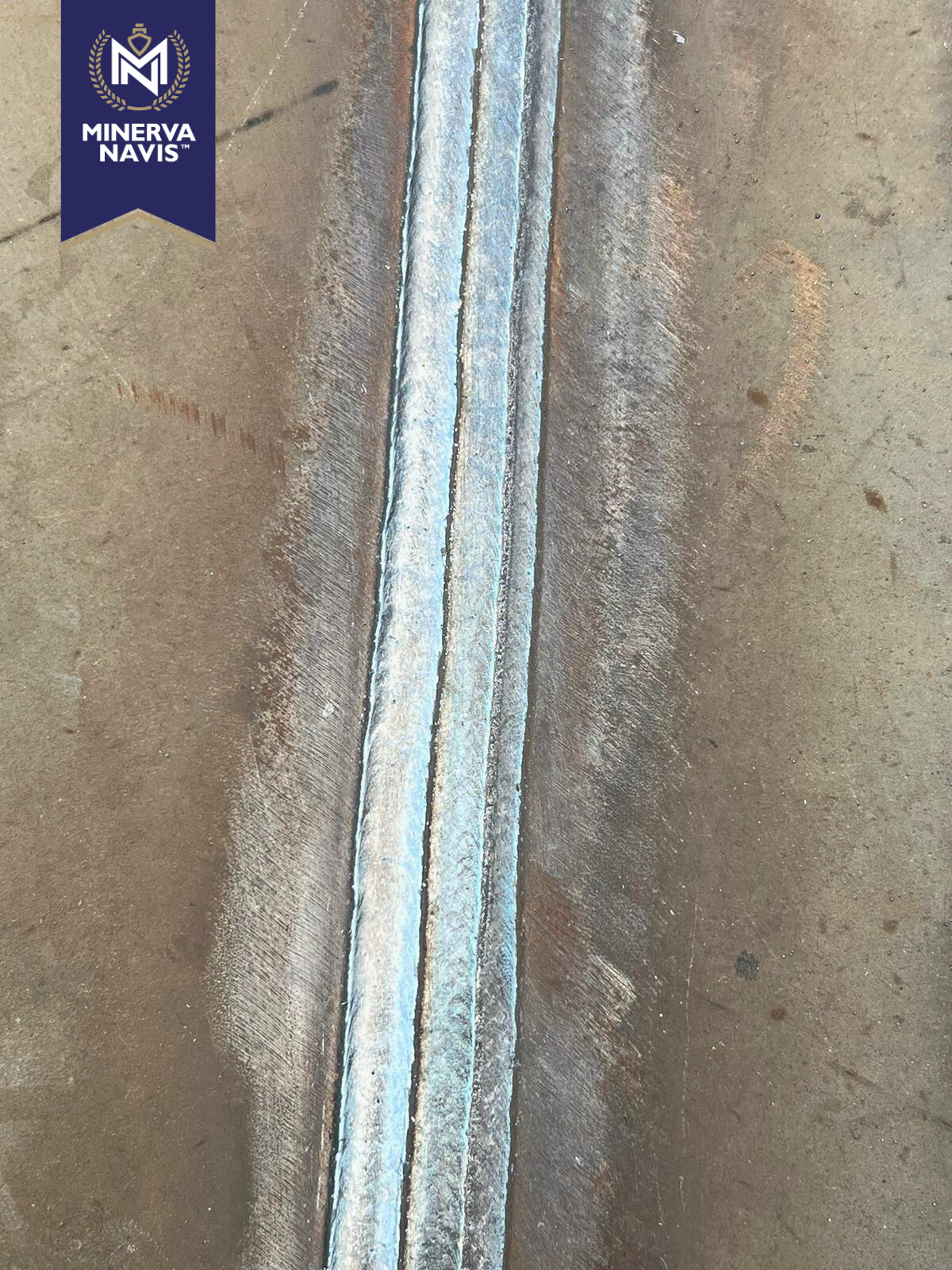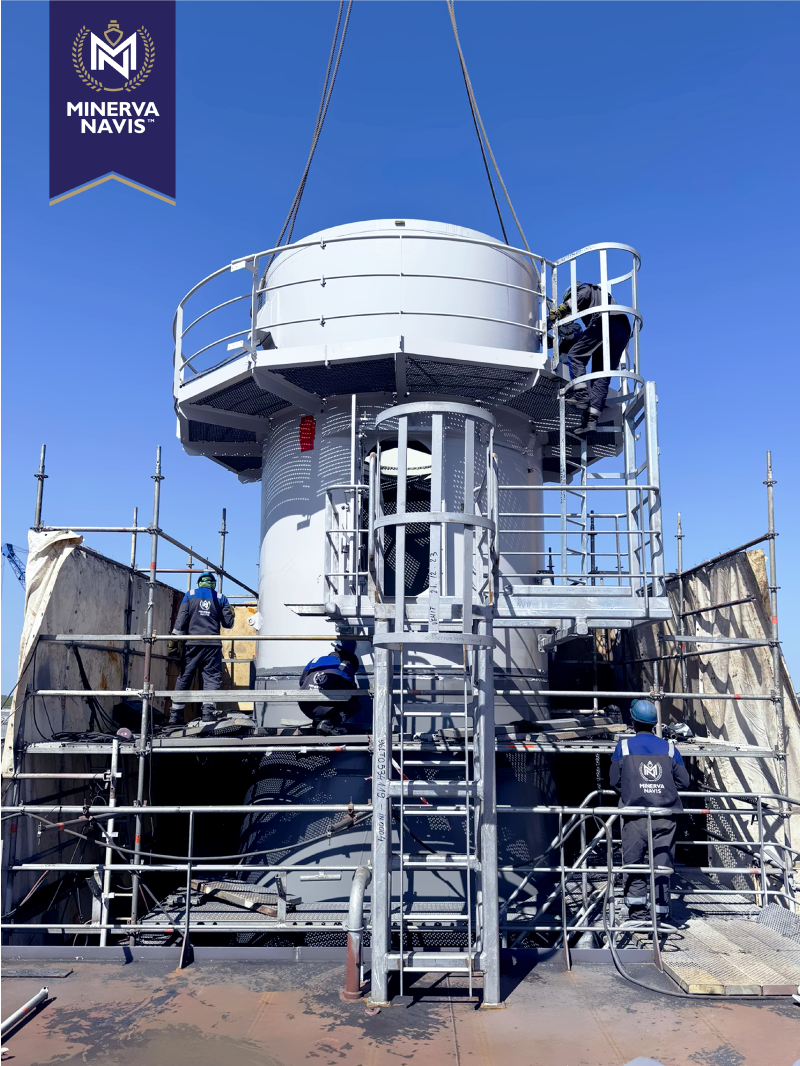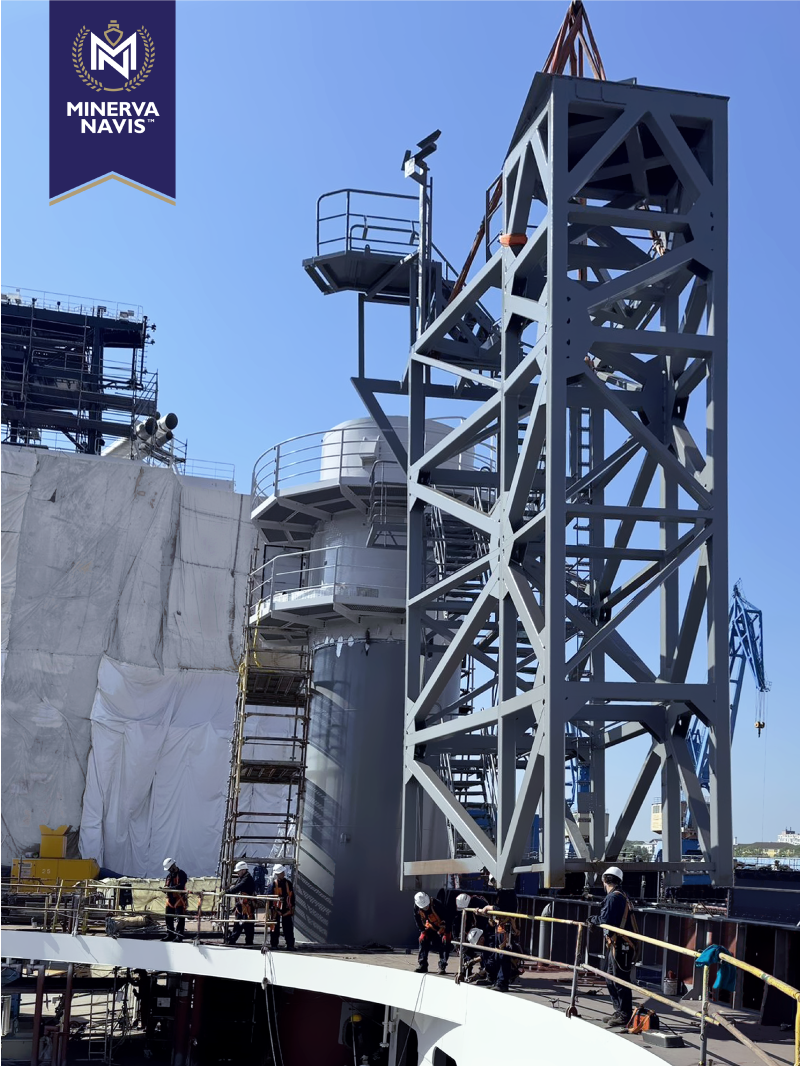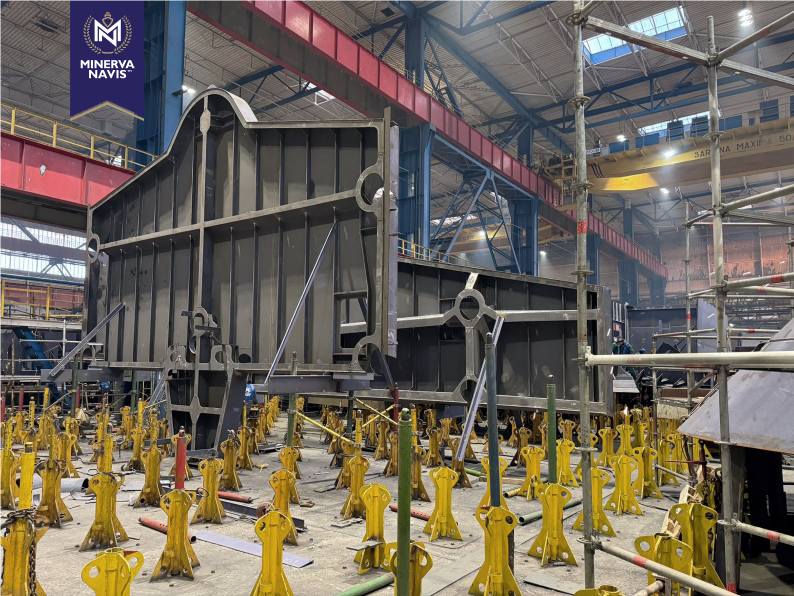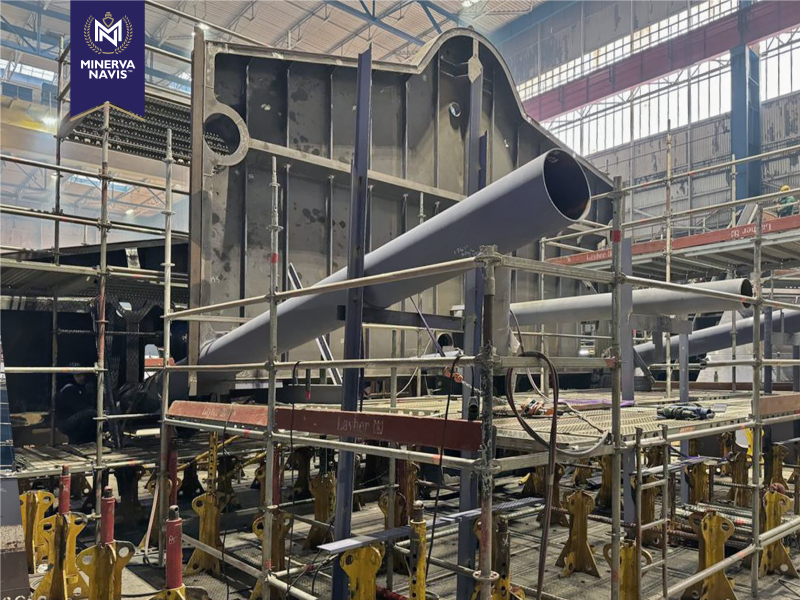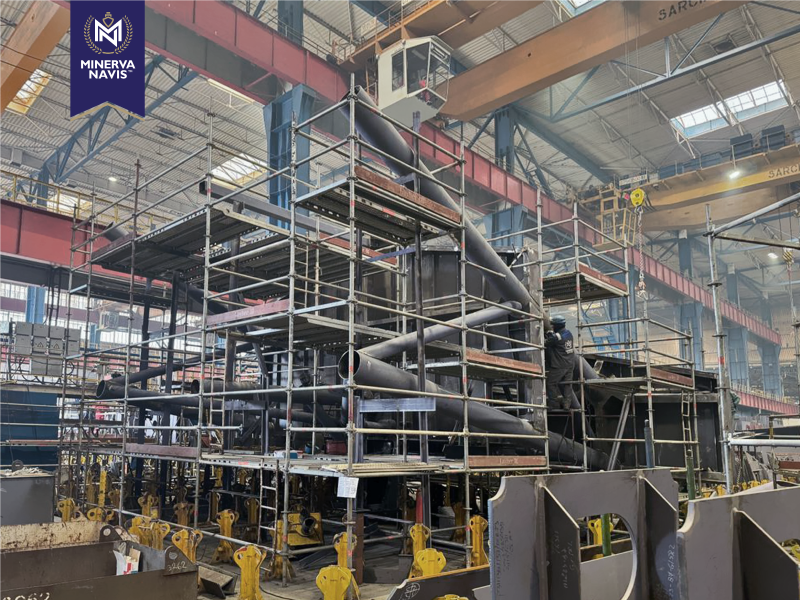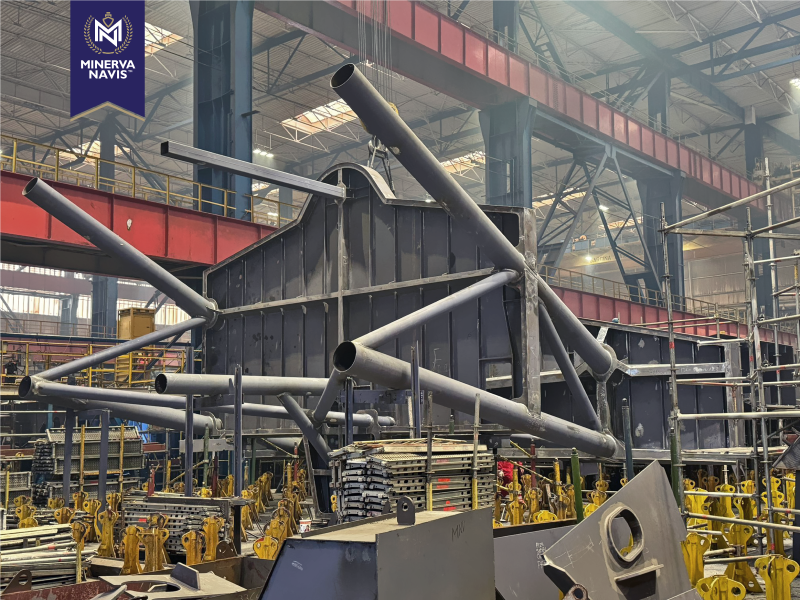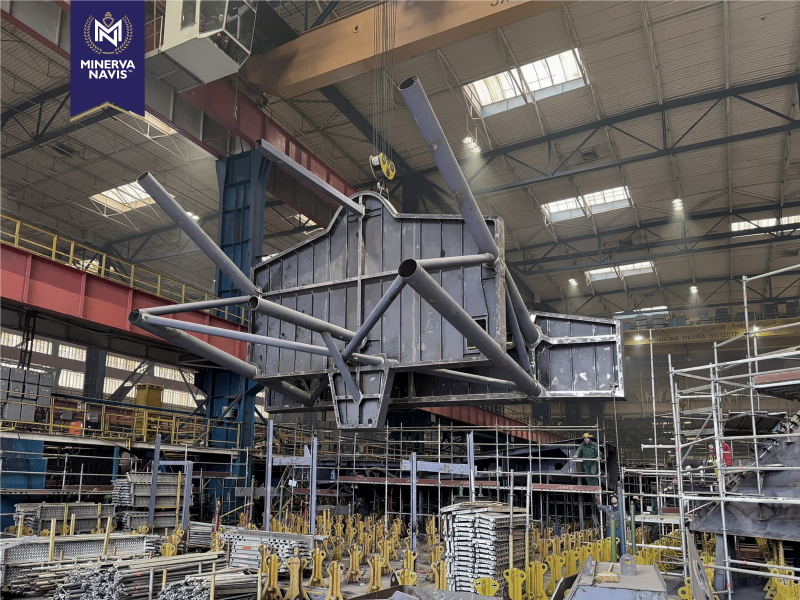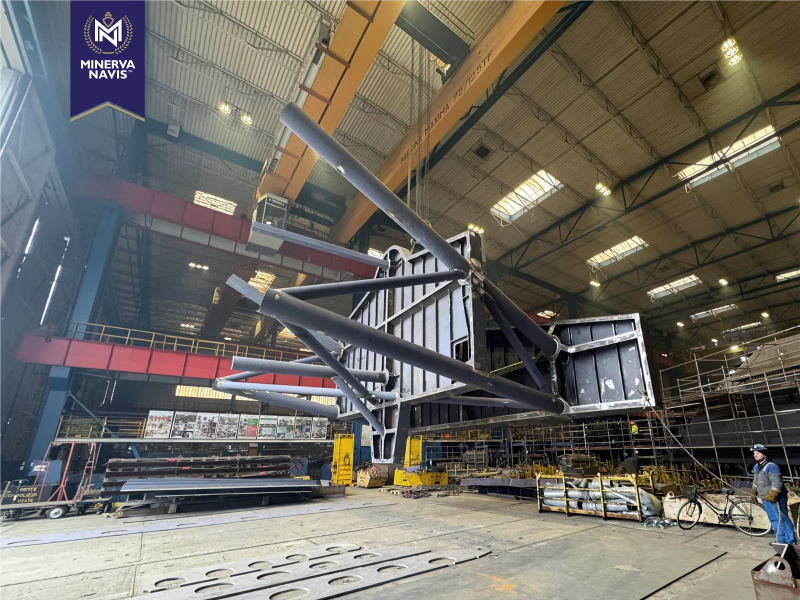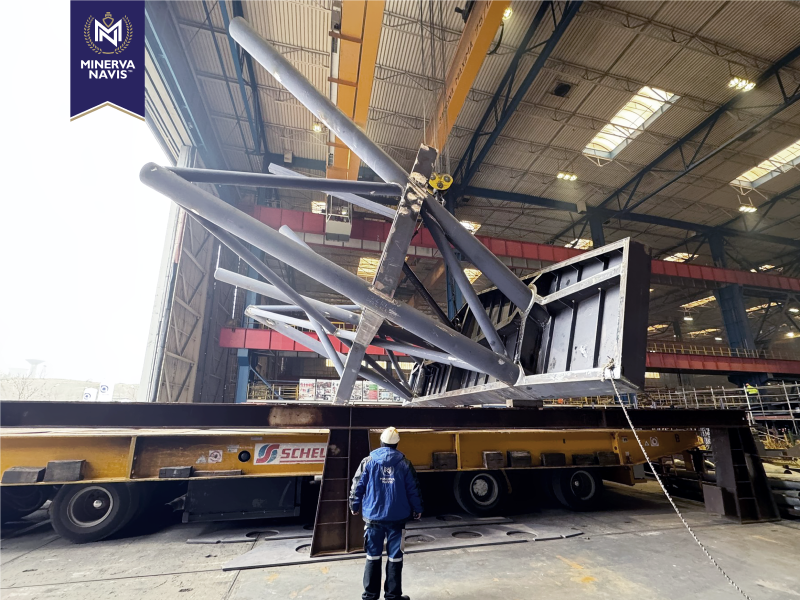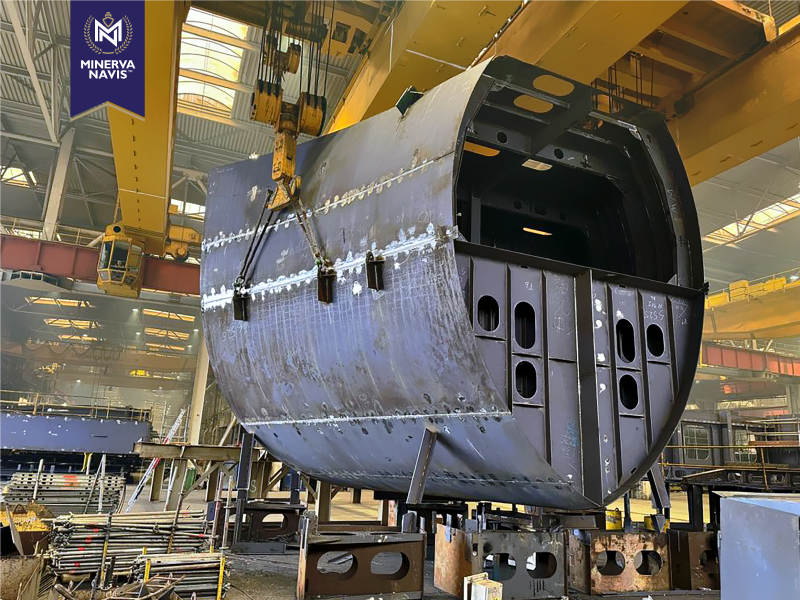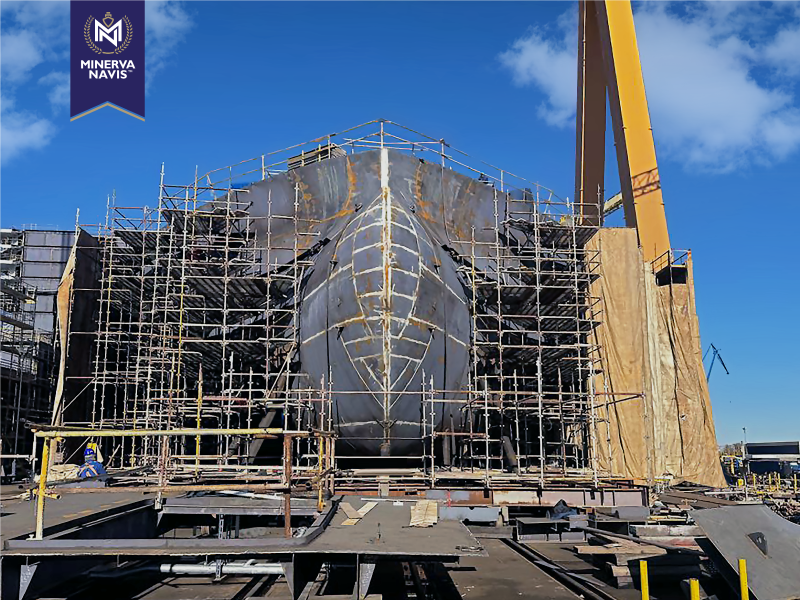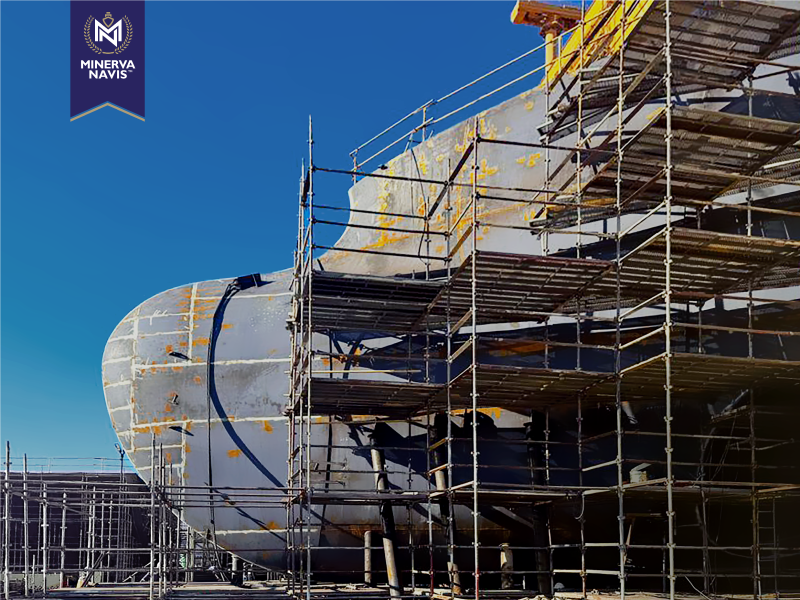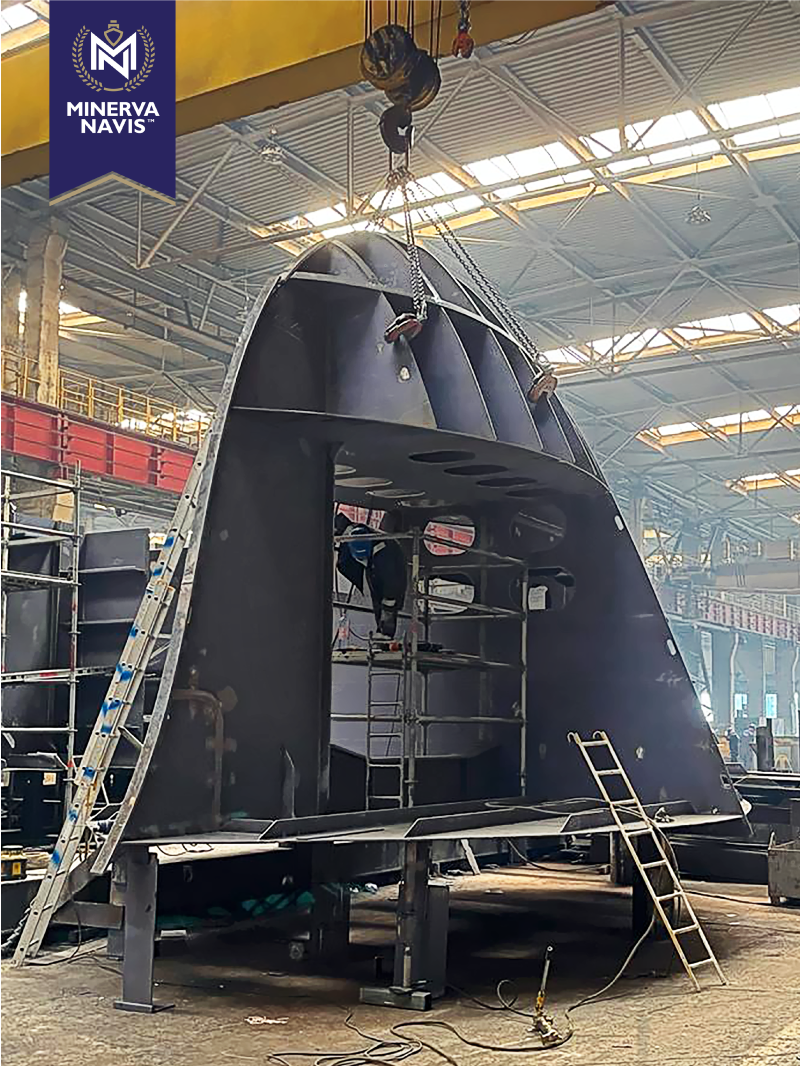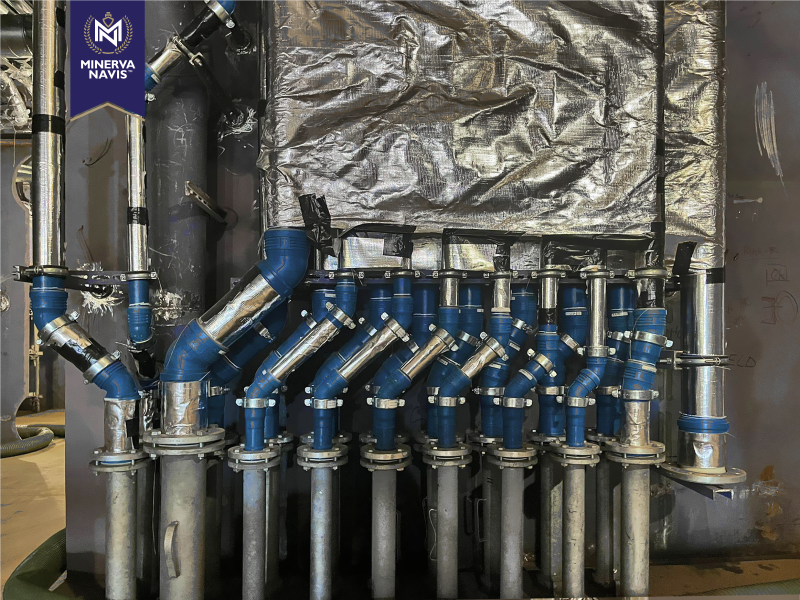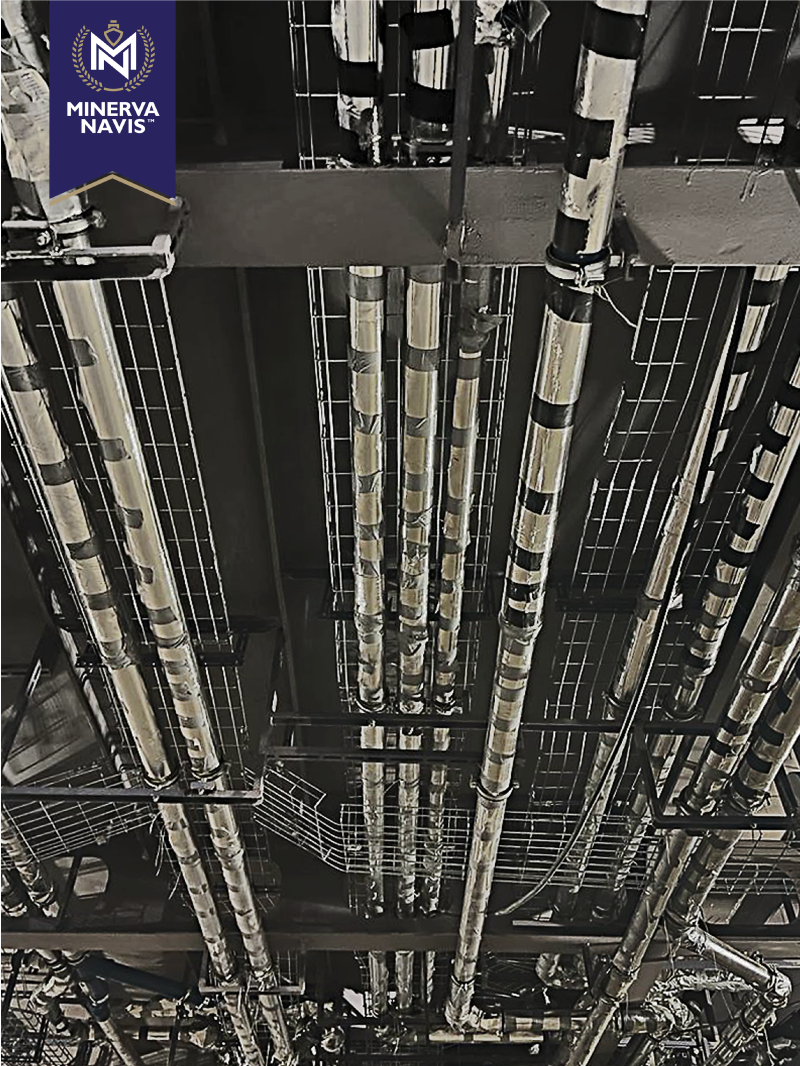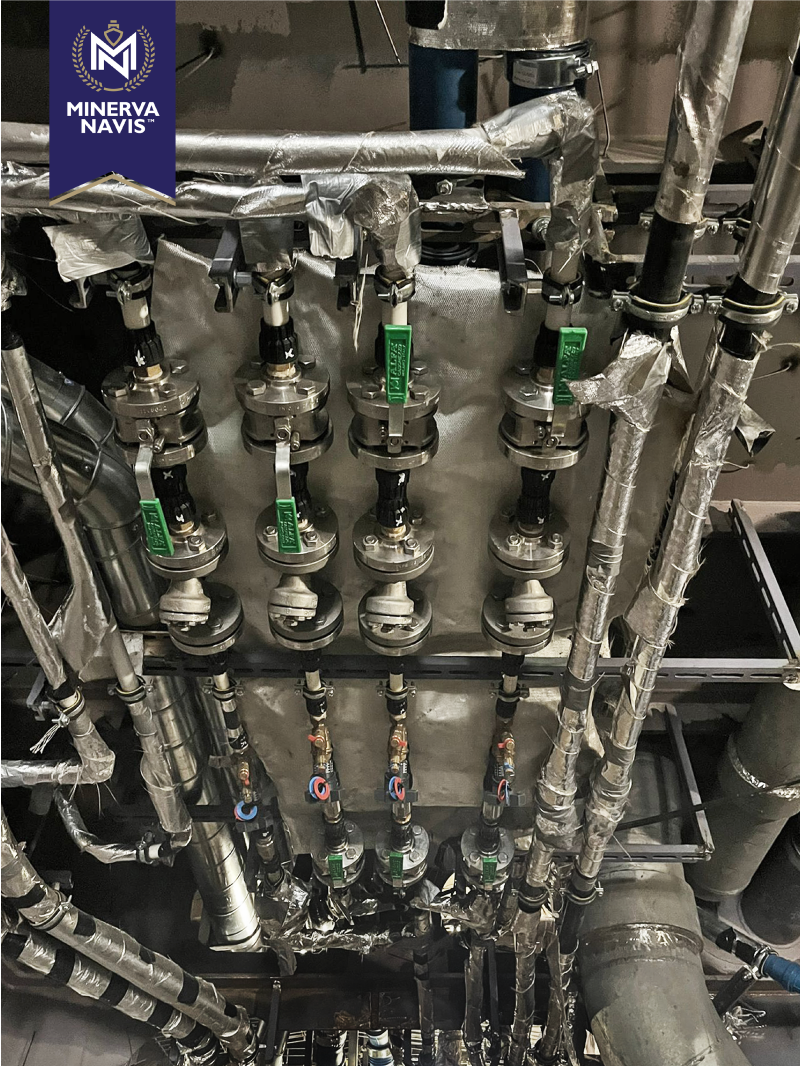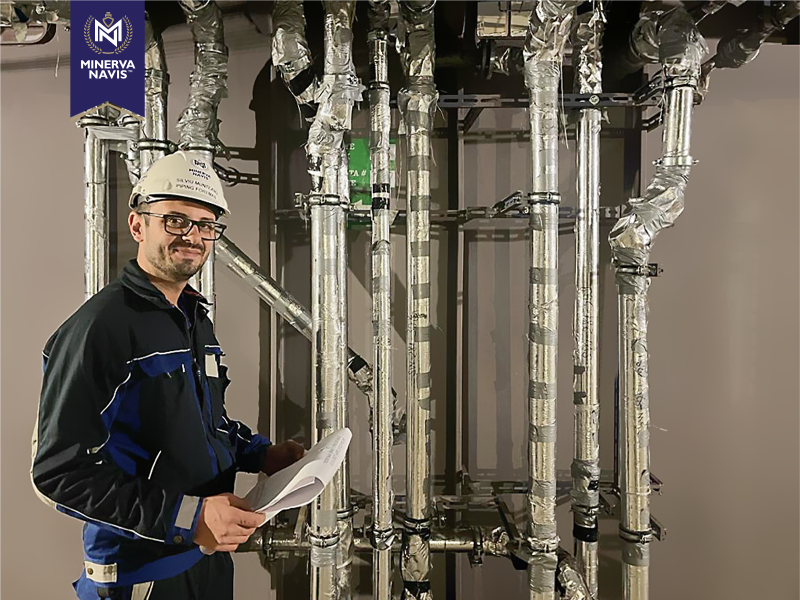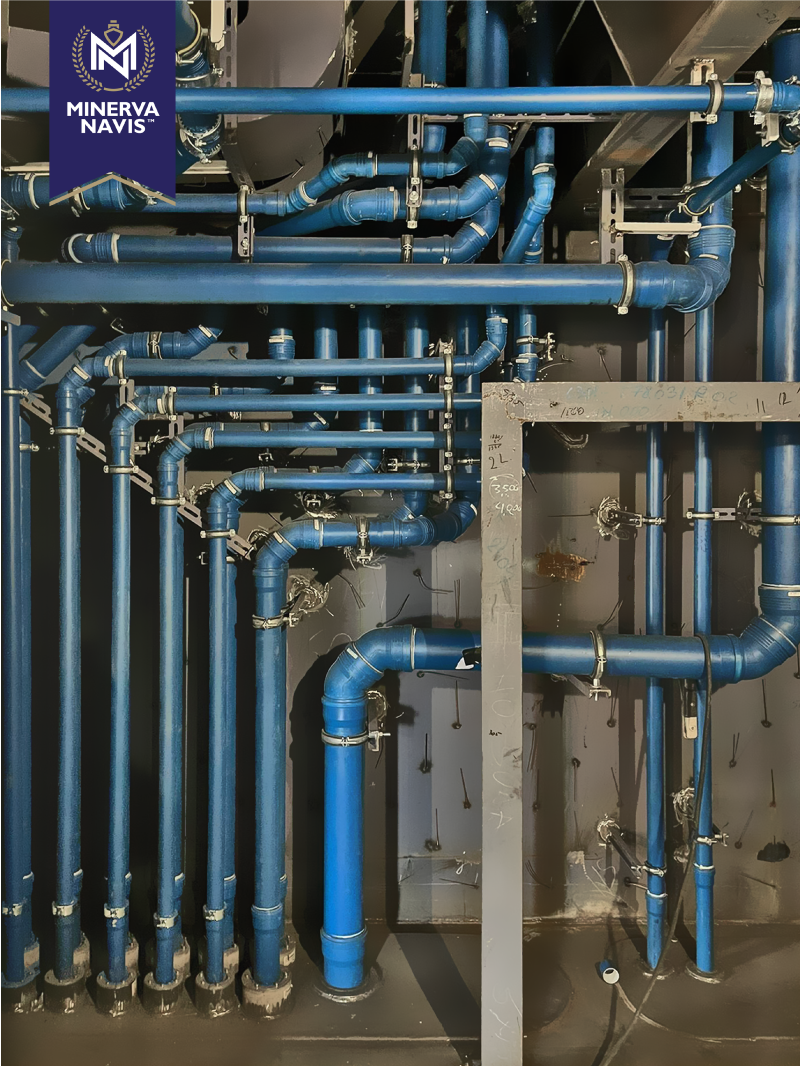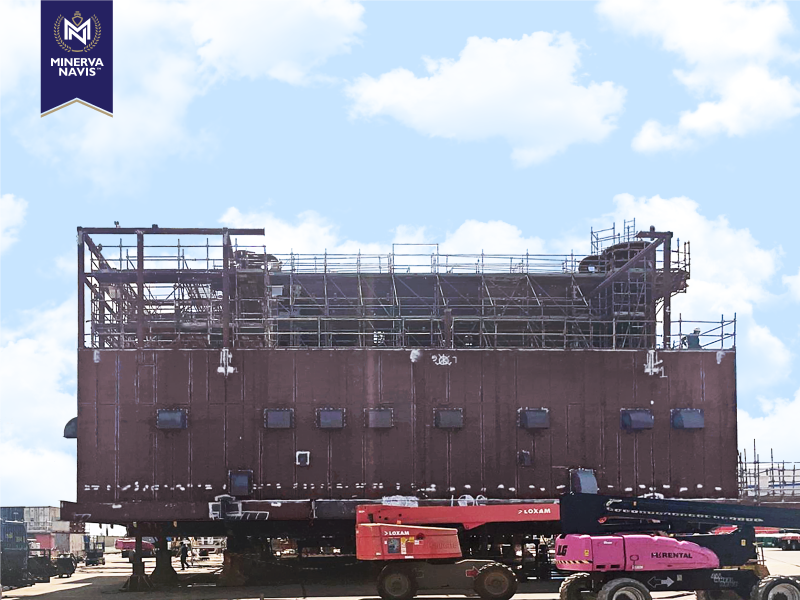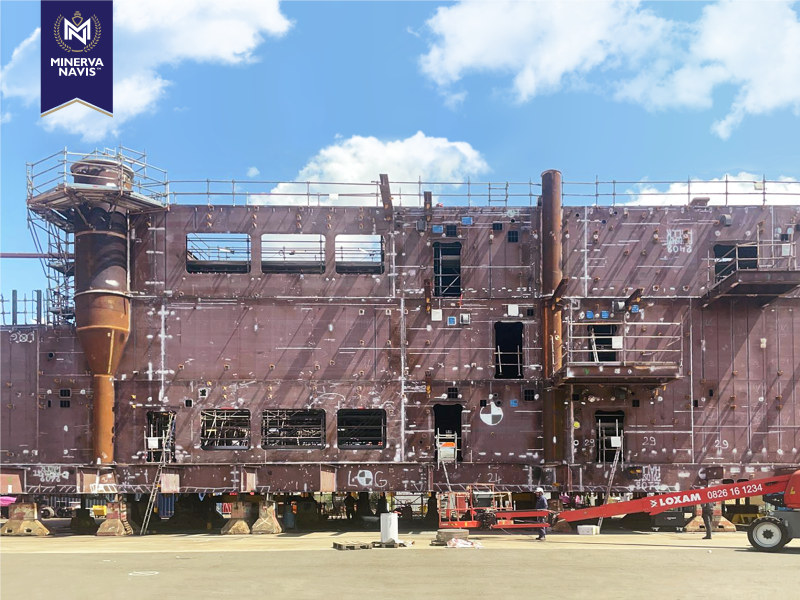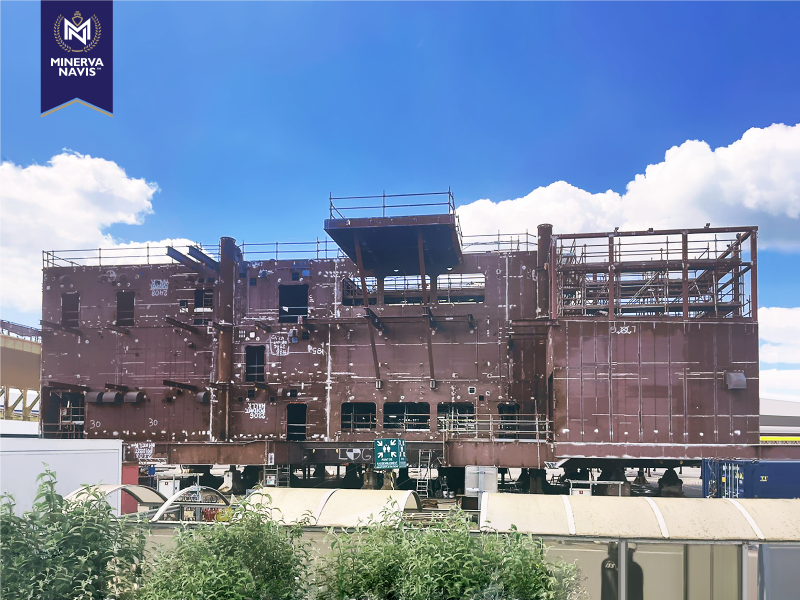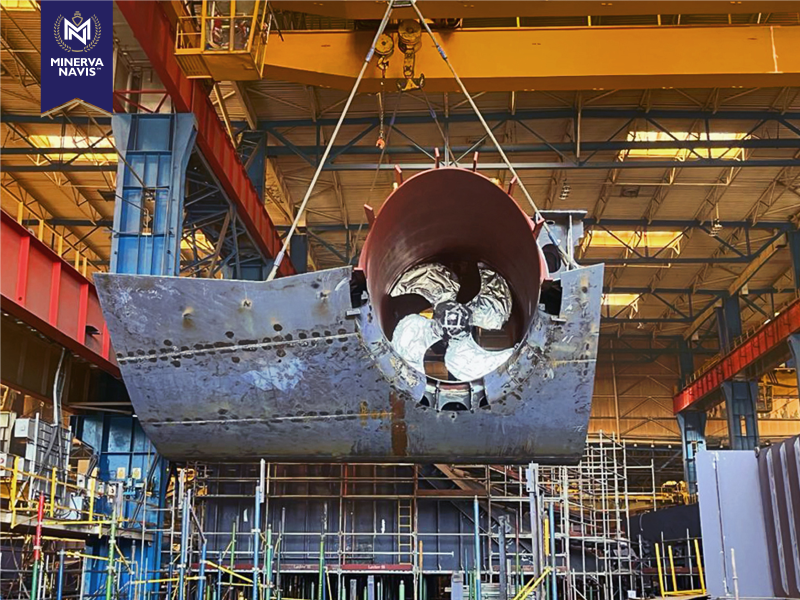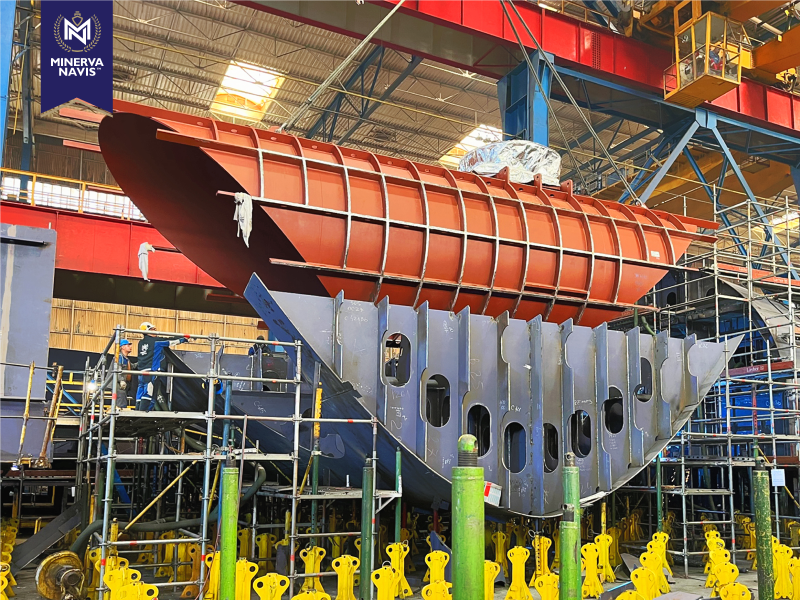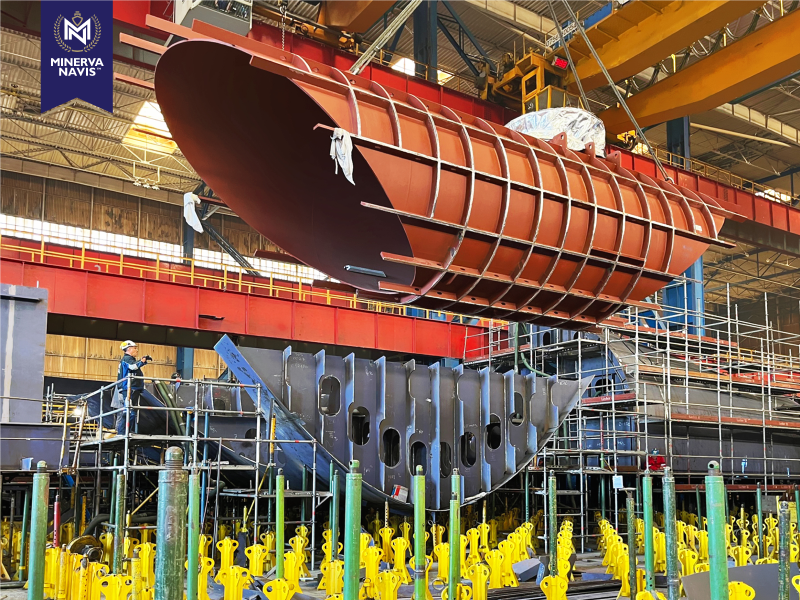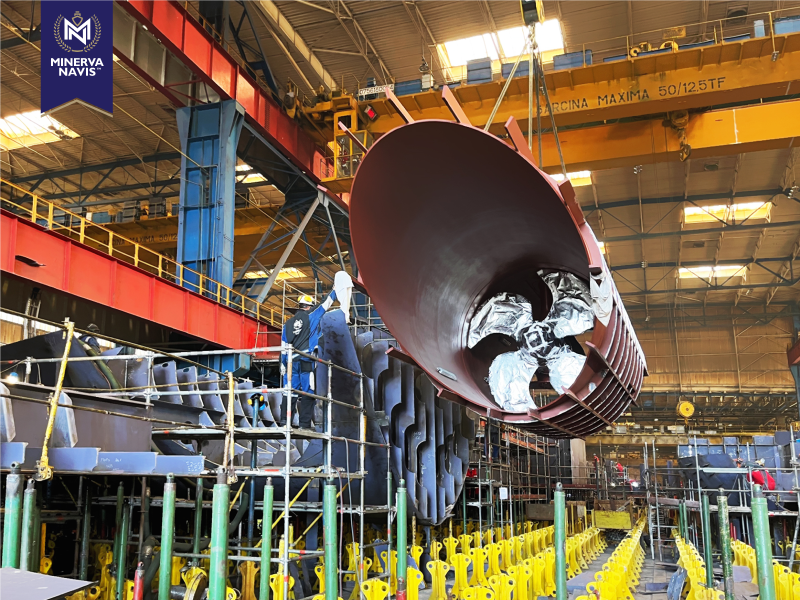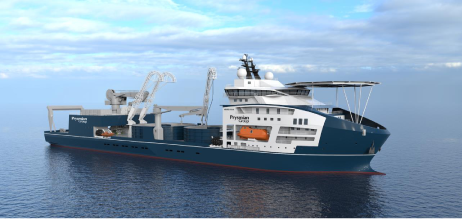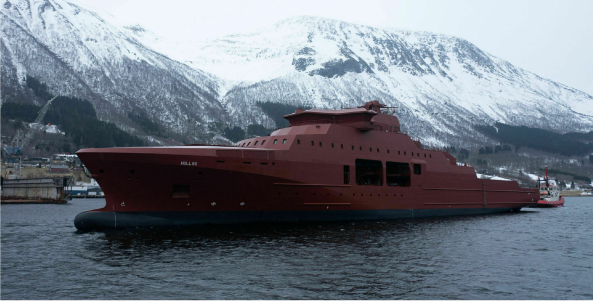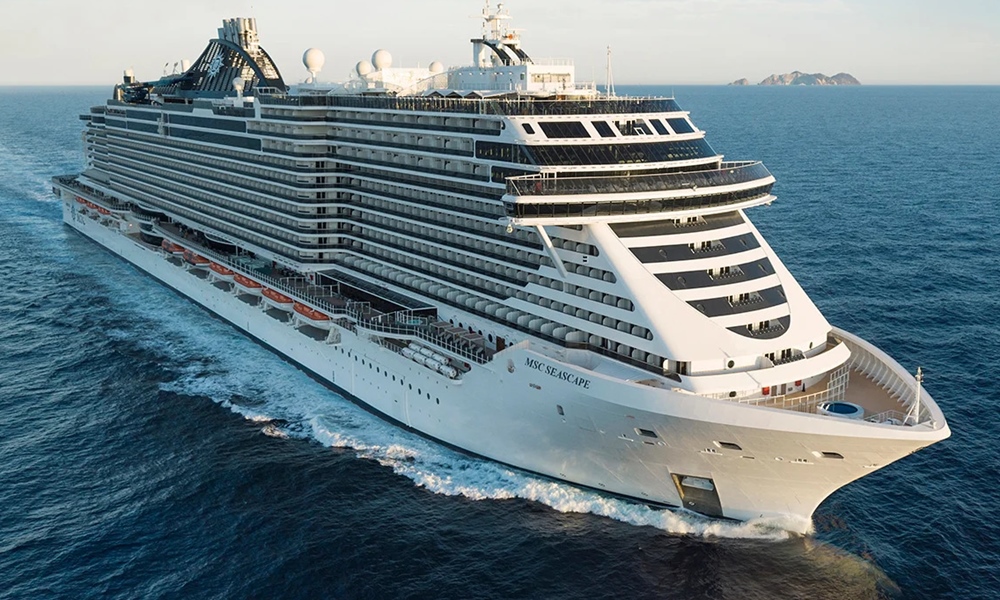some of our
Our staff is trained and certified based on industry standards and regulations to operate construction works on any type of ship with the highest sense of responsibility. We leverage on our employees’ expertise to exceed customers’ expectations as well as guarantee efficient works delivery.
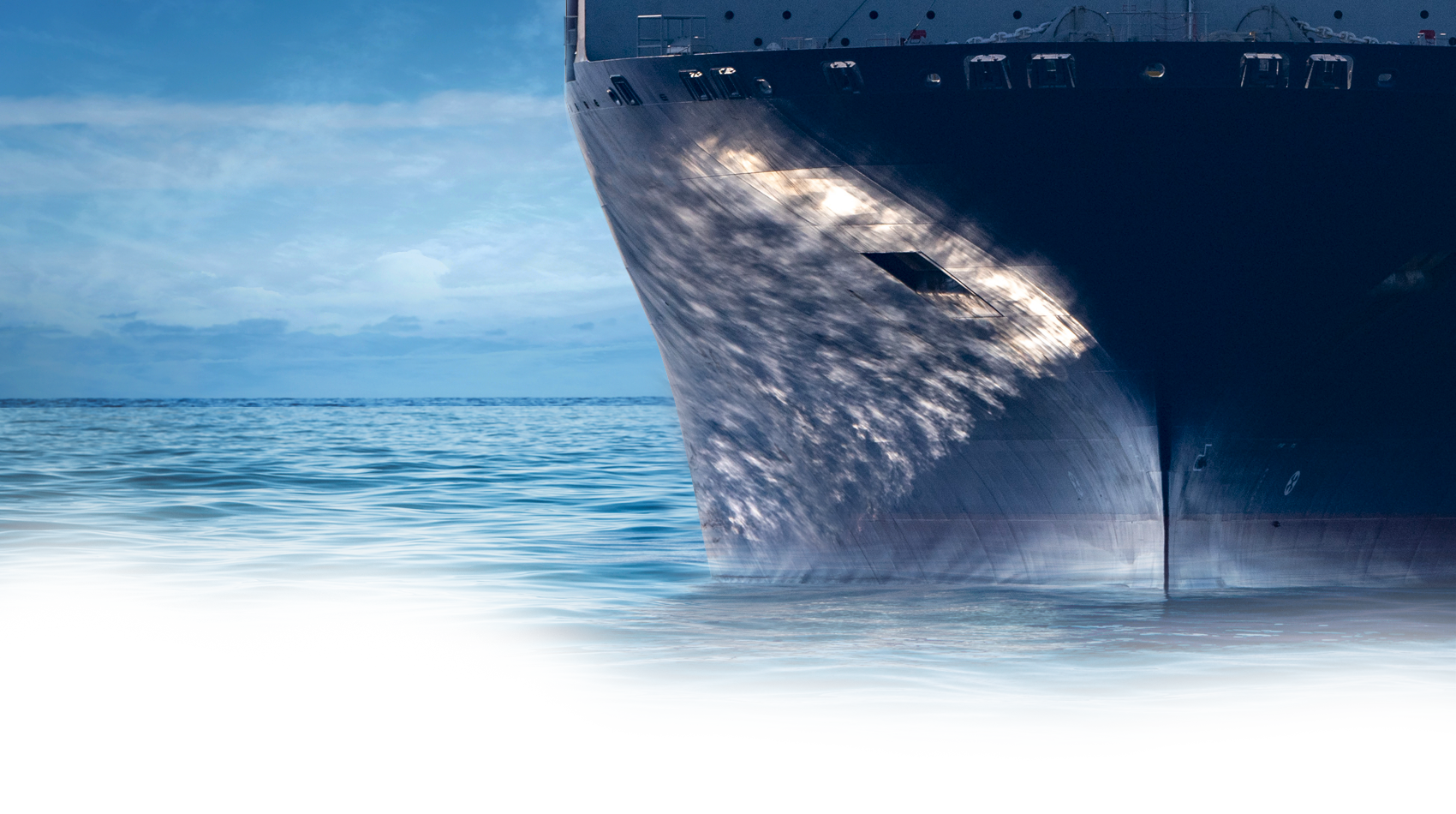
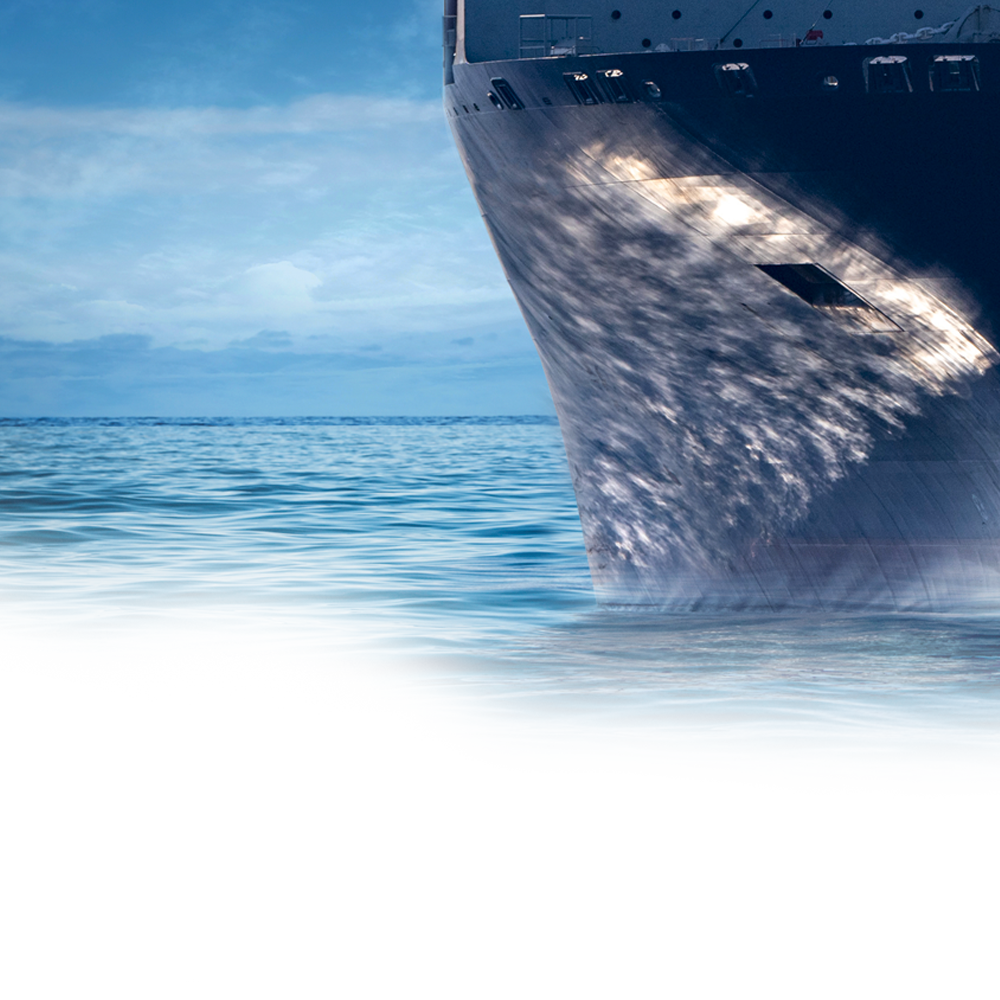
Disney Adventure – A Naval Giant Completed with the Contribution of Minerva Navis
Disney Adventure is one of the largest cruise ship projects currently under construction in Europe:
- 208,000 GT
- 342 m length
- 46 m breadth
- 2,111 cabins
- Capacity: 6,000–6,700 passengers + ~2,300 crew
Originally built as Global Dream in Germany, the vessel was later acquired by Disney Cruise Line and completed under the coordination of Meyer Werft, with major technical and operational upgrades — including the integration of low-emission methanol-based propulsion systems.
Minerva Navis Involvement
For one year, Minerva Navis contributed to critical work during the final construction stages:
- Hull construction works
- Installation and interventions in technical interior zones
A team of 50 specialists operated in areas with tight tolerances and strict quality requirements, contributing directly to the completion of a flagship vessel for the cruise industry.
Proven Expertise
Participation in Disney Adventure confirms Minerva Navis’ capability to execute highly specialized work in large-scale shipbuilding projects, fully aligned with the standards required by major international shipyards and global cruise operators.
The particularity of these two structures is that the azimuth equipment — key components of the vessel’s propulsion system — will be installed inside them.
Challenges
The works were defined by a complex double-curved geometry, both transversally and longitudinally. These are advanced structures, featuring a dense network of internal elements.
The main difficulty came from the extremely tight tolerances — only ±4 mm flatness — combined with restricted working spaces, sometimes as small as 400 x 400 mm, which limited team and equipment access.
To achieve perfect geometry, a complex welding strategy was applied, specifically designed to control the structure’s stresses and deformations.
At the end, all welds were verified through full ultrasonic testing (NDT – 100% UT), confirming complete compliance with technical requirements and Minerva Navis quality standards.
Result
The work was executed to the highest quality standards, to the full satisfaction of the client.
Zero stress. Zero issues. Only satisfaction.
This is what shipbuilding excellence looks like — the Minerva Navis signature.
A New Bulbous Bow, Another Demonstration of Minerva Navis Precision
Minerva Navis steps in where the work becomes complex — where others lack the necessary expertise.
Our company brings together highly recognized specialists in shipbuilding and stands out through its consistent focus on top performance and exemplary discipline.
This bulb, known as one of the most complex structures of the vessel’s hull, was executed by Minerva Navis teams through outstanding coordination and rigorous control at every stage of the process.
The Result:
All welds successfully passed 100% NDT inspection, the execution deadline was fully met, and the client expressed complete satisfaction.
This achievement stands as further proof of the high-level expertise and excellence standards that define Minerva Navis.
The bulbous bow directly influences water flow along the ship’s hull, contributing to enhanced stability and reduced hydrodynamic resistance.
Challenges:
The ship’s bulbous bow has a complex three-dimensional shape with double curvature — none of its surfaces are flat.
Each prefabricated section had to be aligned with extremely tight tolerances, as even a deviation of just a few millimeters can directly impact the vessel’s hydrodynamic behavior.
If the actual shape does not match the designed profile, it can lead to increased drag and reduced hydrodynamic efficiency.
To ensure the required precision, laser measurements, metal control templates, and constant checks are used at every stage of the process.
The bulbous bow is welded impeccably. Any welding defect could compromise the structure or performance of the vessel.
For this reason, NDT (non-destructive testing) inspections are rigorously carried out to confirm the work complies with the highest standards.
The Result:
A construction executed without deviations and without compromise.
The project was delivered on time, fully validated, and praised for its execution quality — another achievement that strengthens Minerva Navis’s position as a leader in shipbuilding in Romania.
3 mm tolerance. Zero errors. 100% performance. Only at Minerva Navis
The fixed skeg is a crucial structural component mounted below the waterline, on the ship's bottom, along the longitudinal axis. Its contribution is vital for:
- Reducing lateral drift – It helps the vessel maintain its desired direction in wind or side currents, minimizing transverse slippage ("sideslip").
- Increasing directional stability – It acts like an underwater "wing," stabilizing the trajectory and reducing the strain on steering systems.
- Precision in specialized operations – For a Cable Layer vessel, precise positioning is critical. The skeg assists in maintaining the correct course during submarine cable laying.
Challenges:
The execution involved adhering to strict flatness and dimensional tolerances – only ±3 mm – an extremely rigorous requirement in the shipbuilding industry, demanding meticulous planning and flawless execution.
The welding process was equally demanding. The welds, critical for structural integrity, were performed to the highest standards and passed non-destructive inspections.
Additionally, mounting and welding stainless steel parts required welders skilled in handling sensitive materials and special procedures.
The skeg’s geometry, featuring complex aviation-like shapes, required the use of shaped steel and stainless steel plates that were modelled and joined to precisely replicate the designed form. The result is a structure that is not only functional but also visually remarkable – what we call Good Looking.
The result? A total success.
The work was delivered on the first try, with no comments, no touch-ups, no compromises. Everything was perfectly within the assumed deadlines, ensuring the client’s lift schedule remained intact – no delays, no deviations.
This is the kind of delivery that leaves no room for doubt: Minerva Navis means excellence executed to the millimeter.
When everything has to be perfect, Minerva Navis is the solution.
The cable laying vessel is designed to install submarine telecommunications cables, power transmission cables (including high-voltage ones), as well as cables for monitoring systems or offshore infrastructure.
This construction is one of the most spectacular structures featured on this specialized vessel. Positioned at the ship's stern, these components are part of the system that guides and carefully deploys the cable to the seabed during offshore operations.
It is a complex, uniquely shaped project, difficult to assemble and install, requiring precision, coordination, and expertise at every stage.
Challenges
Assembling and installing the submarine cable guiding structure at the stern of the vessel was one of the most complex phases of the construction. With double-curved geometries and executed in extremely tight spaces, the work demanded millimetric precision and flawless team coordination.
The assembly was carried out in phases, each with strict rules, and the welding was done according to advanced technical procedures that leave no room for error.
The result? A complete success.
The work was delivered to the client on the first try, with no remarks – a clear confirmation of the professionalism and dedication of the Minerva Navis teams.
Congratulations to everyone involved for the exemplary collective effort! The deadline was met, and the quality of the work reached the highest standards, as required by such a complex project.
A Battle of Millimeters: The Assembly of a Bulbous Bow that Allowed No Room for Error
This critical element of naval architecture plays a major role in the vessel's performance, reducing drag and optimizing fuel efficiency.
Challenges:
The construction process involved working with plates of varying thicknesses and shapes, demanding extreme precision to avoid any deviation from the designed form.
The challenges of alignment and maintaining precise geometry were overcome through skill and experience.
Despite tough conditions and limited working space, our teams delivered at the highest standards, with all NDT inspections passed flawlessly.
The Result?
A project delivered on time, free of non-conformities, and praised by both the client and the classification society.
- Professionalism
- Precision Execution
- Commitment to Excellence
With every project, Minerva Navis strengthens its position as a trusted partner in modern shipbuilding.
As part of Project N 963, Minerva Navis has developed a critical structure for anchoring smaller vessels used to transport maintenance personnel operating in offshore wind farms. This structure plays a vital role in ensuring safe and efficient docking when supply vessels approach the main ship, facilitating the swift and secure transfer of personnel and equipment.
Challenges
The project required the construction of a 13-ton irregularly shaped pipe structure, which had to fit perfectly onto the ship’s hull. Each pipe component was meticulously shaped to follow the specific contours of the vessel, demanding exceptional precision in execution. Additionally, all welds were performed with full penetration and were subjected to rigorous quality control, being 100% verified using Non-Destructive Testing (NDT) technology to ensure the structural integrity and strength of each joint.
Minerva Navis successfully delivered this project without any issues, strictly adhering to deadlines and technical specifications. Our skilled fitters assembled each component with extreme accuracy, while our welders executed flawless welds, demonstrating a high level of expertise and professionalism. The final result was a complete success, with the client fully satisfied with the quality and execution of the work.
The New Standard in Ship Stability: An Anchor Niche Designed for Extreme Conditions!
The anchor niche is a compartment within the ship's structure, typically located at the front, designed to house the anchors. A modern anchor niche is engineered to optimize weight distribution and significantly reduce vessel sway during anchoring and under harsh weather conditions. By positioning and optimizing this compartment, lateral movement of the vessel is reduced, significantly enhancing overall stability.
Challenges:
Building the anchor niche demanded seamless integration into the ship’s structure, a process that requires high precision. Given the size and weight of the massive components involved, each part had to be installed with utmost accuracy to ensure the ship’s stability and safety under challenging operational conditions. The thickness of the plates and the complex compartmentalization within confined spaces presented unique challenges, necessitating meticulous planning and flawless execution.
Every weld underwent rigorous ultrasonic testing (US), used to inspect the internal structure of the joints, ensuring there were no cracks, pores, or other imperfections that might compromise long-term strength. This inspection method allowed us to achieve an exceptional level of safety and quality for this project, adhering to the highest industry standards and ensuring lasting durability of the structure.
Minerva Navis completed the work on time and to an exceptional standard of quality. Our experts in fitting, welding, and surface preparation surpassed expectations with this flawless delivery. The client’s response was one of enthusiasm and complete satisfaction with these results. With every project, we reinforce our position as an industry leader.
Mechanized welding in the shipbuilding industry is a sophisticated process that requires highly skilled welders to operate automated equipment. For this type of welding to ensure both speed and outstanding quality, it is crucial that welders are exceptionally well-trained, accurately set the technical parameters, and adjust the process to suit environmental conditions. Additionally, they must continuously monitor weld quality to guarantee flawless results.
The mechanized welding carried out by our teams plays a vital role in ensuring the structural integrity of the ship, significantly contributing to its durability and safety.
Our clients benefit from:
- Exceptional welding quality
- Reduced welding costs
- On-time project completion
The welding specialists at Minerva Navis perform mechanized welding daily at the highest standards, particularly in the processes of prefabrication, assembly, and mounting. In this context, we would like to extend our thanks to Mr. Mureș Nicolae, not only for his impeccable work but also for the images captured during the operations, which we are pleased to share on this occasion.
Crane Pedestal: The Key Element That Can Make or Break Ship Operations – Minerva Navis in Action.
The crane pedestal is an essential element in the operation of the ship-mounted crane. This pedestal is a pillar, which serves as a rotation axis and support for the crane arm.
Here are some key aspects of a crane pedestal:
- Structural Support: The pedestal provides support and stability for the crane arm and associated mechanisms, allowing for safe lifting and handling of loads.
- Mobility: This pedestal allows the crane arm to pivot or rotate, offering flexibility and the ability to maneuver loads in various directions and positions.
Challenges:
Installing the crane pedestal on a ship is a complex and difficult process, requiring attention to detail and advanced technical skills.
- Flatness: It is essential that the base of the pedestal be perfectly flat to ensure stability and proper operation of the crane. Deviations here are a maximum of 0.15 degrees.
- Verticality: The pedestal must be mounted perfectly vertically to allow for proper rotation and operation of the crane. Deviations here are on the order of microns. A micron is 1,000 times smaller than a millimeter.
- Welding: Welding the crane pedestal is another critical aspect. This operation must be performed by elite welders. The entire weld is NDT controlled. A poor weld can lead to the displacement or even the collapse of the crane pedestal, which could cause significant damage to the ship. This could affect both the structure of the ship and its functionality.
Was it difficult? Yes! It was all about expertise and extreme precision. The result: the work was delivered to the client flawlessly, without any remarks.
At Minerva Navis, every job becomes a worry-free experience for our clients. They can confidently monitor the progress, knowing that their work is in safe hands and will be successfully completed.
Words from our Foreman Roșca Nicu: "For this job, I collaborated with the best and most experienced fitters from the team I lead. For me as a Foreman, it is a pride to execute such works."
A ship's mast is an essential technology hub, being equipped with advanced functionality including communication systems, GPS, navigation lights, sound warning and lighting, all of which contribute to the efficiency and safety of sea travel. Therefore, the mast ensures the precise and safe navigation of the ship, being a crucial pillar in the management of maritime operations.
Each mast is designed to meet the specifications and needs of the vessel it serves, thus becoming a unique and customized construction that contributes to the vessel's identity and functional efficiency.
Challenges:
The construction of this mast involved significant difficulties, especially highlighted by the need to work with a variety of rays, angles, and inclinations.The elements of the work had to be adjusted with extreme precision during the construction phase, to ensure that the final structure is not only aesthetically pleasing, but also functional and durable. Getting this job right requires skill and experience, as each element influences how the mast will interact with external forces such as wind or tension from mounted equipment.
At the same time, the mast has an impact on the balance and stability of the vessel, as changes in the design or weight of the mast can significantly influence the center of gravity of the vessel. A wrong execution of the work could adversely affect the maneuverability and safety of the vessel, increasing the risk of capsizing or difficulties in navigation.
These details make mast construction a painstaking and highly specialized task.
Minerva Navis demonstrated an outstanding performance in the execution of this complex work, managing to complete the project on time and hand it over without objections. Our top foremen, including skilled fitters and welders, have outdone themselves in making this impressive structure.
The contribution of our grinders was no less important; they perfected the work cosmetically, ensuring that every detail is finished with the utmost care. This achievement underscores Minerva Navis's commitment to excellence and quality, reinforcing its reputation as a leader in the shipbuilding industry.
True technical mastery: the complex and rigorous process of assembling, centering and mounting the ship's bulb by Minerva Navis.
Strategically placed at the front of the ship, the bulb shapes the course of the water, cleaving the waves with a special grace. This master of hydrodynamics reduces the force with which water opposes the ship's forward motion, thereby saving precious fuel. This technological solution allows an increase in the speed of travel by about 7-10%, thus reducing the operating costs of the vessel.
In rough waters, it becomes a reliable ally, giving the ship impressive stability, minimizing rocking and improving maneuverability.
Challenges:
In the assembly phase, it was key to create and preserve an impeccable flatness of the structure, the section being built on the transversal wall at the stern. Due to the significant height, every millimeter counted; any deviation from perfect flatness could have created a domino effect, disrupting the verticality of the central member and, by extension, compromising the precise alignment of the entire assembly of transverse and longitudinal members.
A major challenge was the installation of the outer cladding sheets, of different thicknesses and with double curvature, where our elite foremen, together with our experienced fitters, displayed exceptional technical mastery and accuracy, demonstrating extraordinary skill.
Our top welders were also put to a remarkable challenge due to the extremely confined spaces they had to work in, as well as the considerable volume of welding checked using NDT (Non-Destructive Testing) techniques.
In an amazing display of efficiency, the section was erected without delay, even in the midst of strong wind and torrential rain in a surprisingly short time and with remarkable accuracy, meeting the client's deadline.
Minerva Navis triumphed in the face of this exceptional challenge, successfully completing the work within the deadline set by the site. Our success was remarkable, considering the complexity and difficulty of the operations carried out. Moreover, the work was accepted without any comments by both the Certification Class and the client. This not only confirms our technical competence, but also our commitment to deliver high quality results in shipbuilding. Minerva Navis remains true to its value of excellence.
Minerva Navis is taking a big step towards the future of naval installations. The future belongs to revolutionary materials - stronger, lighter, and extremely efficient in assembly.
Today, we immortalized the efforts of our colleagues, who focused on fitting exotic pipes on a grand cruise ship. Their skill and dedication in assembling these vital components is reflected in each photo.
Our installations are the heart of the ship, turning every cruise into a comfortable and safe adventure for passengers eager to explore.
Challenges:
The installation process is a true art of precision, where every pipe joint is done with enviable craftsmanship. Our team, equipped with patience and meticulous attention, faces the challenge of working in tight spaces, often bordering on the impossible. Each step is a fine dance between rigorous adherence to standards and adaptation to limited spaces, turning each montage into a technical masterpiece.
The quality within these installations is measured by four essential criteria:
- Impeccable visual appearance;
- Absence of vibrations;
- Compliance with technical specifications;
- Absence of counter slopes;
- Resistance to pressure test.
At Minerva Navis, we deliver perfect installations right from the first inspection, guaranteeing customer satisfaction. We are masters in high-quality technical deliveries and perfect tightness at high pressures, where we do not lose a drop of liquid.
Our constant aim is to deliver ahead of schedule, delivering exceptional work every time.
Minerva Navis and green energy
Imagine a world where the wind doesn't just blow, it powers our cities, communities and hearts. At Minerva Navis, we don't just dream of this future, we build it!
We support the global ambition of zero emissions by 2050, actively contributing by building offshore structures for offshore wind farms for our client Chantiers de l'Atlantique in France.
Our offshore structures are more than just buildings: each one provides green energy for 800,000 people. Minerva Navis, carried out prefabrication, assembly and mounting with special attention to quality, the requirements for these platforms being extremely high. They must withstand the forces of the sea and vibrations, which requires top quality materials and welds.
Challenges:
Requirements for impeccable welding. Every weld has been executed and checked with the utmost attention, because the resistance depends on it. With 50% of welds controlled by U.T. and with large extensions to the smallest defect found, we left no room for error.
Execution of the construction without affecting the sheet metal field. Special metal plates of the highest quality were used. The surfaces were prepared with the greatest care and for large thicknesses, over 30 mm, preheating was done. The use of the hammer was prohibited. The sheet metal fields were tested with M.T..
We proudly delegated an elite team for these operations, who not only delivered brilliantly, but were also appreciated, receiving direct praise from the client. Coordination was masterfully orchestrated by our seconded engineer and foremen.
Our welders shined, exceeding expectations with a formidable 97% pass rate in welding tests. And our fitters, masters of precision, have perfectly combined quality with speed, consolidating the reputation of excellence we have in the field.
The thruster tunnel helps the 360 degree maneuver of the ship.
This propulsion system is in the bow of the ship and helps with better maneuverability. The system facilitates docking, because ity allows the captain to turn the ship to port or starboard without using the main propulsion mechanism.
Challenges:
The biggest challenge was when connecting the 67 ton section with the 47 ton thruster tunnel, so that at the end there would be a flatness deviation of ±1 mm.
The complexity of the section is given by the thickness of the plates, plus the intersections between the longitudinal and transversal sections.
For this work, we had 80 lm of US controlled welding and 100 lm of controlled welding with penetrating liquids and magnetic powder.
Minerva Navis successfully completed this job, at the deadline required by the shipyard and at a superior quality. The client accepted the work from the first visit, without observations.
N 872 - Prototype ship
Manufactured, Assembled, Welded
This was a prototype ship, the execution was difficult due to the experimental technical documentation. It was necessary for Minerva Navis to work in parallel with the Technical Department to update the documentation in real-time based on the information from the production teams.
The biggest challenge was to execute the work successfully without having the exact technical documentation. The project’s success can be attributed to our coordinators who have significant experience and expertise in this particular field.
Incomplete technical documentation along with various complex problems during production led us to perform the work step by step, directly onboard the ship. Together with the design team, Minerva Navis devised solutions to respect Azipull's quotas.
The design engineers took the information from our production specialists and remodelled the head-box, successfully completing this challenging project.
N 6282 – Cruise ship
Our Our client was concerned that the stabilizer had been compromised after being dropped on the ground, which would have been a devastating financial loss. Minerva Navis was selected to perform the repairs given the team’s expertise in problem solving.
We accepted the challenge and immediately started working. The whole process was spectacular: Seven workers were operating seven hydraulic presses simultaneously inside the stabilizer, while on the exterior side, workers were straightening with flame tools.
One of our best foremen with extensive experience in the field was the leader on this project. The entire team adhered to his instructions completely. Finally, thanks to our cautious and methodical process, the stabilizer was back in shape. Our team did a fantastic job and we were extremely thrilled to see our client completely satisfied with the end result.



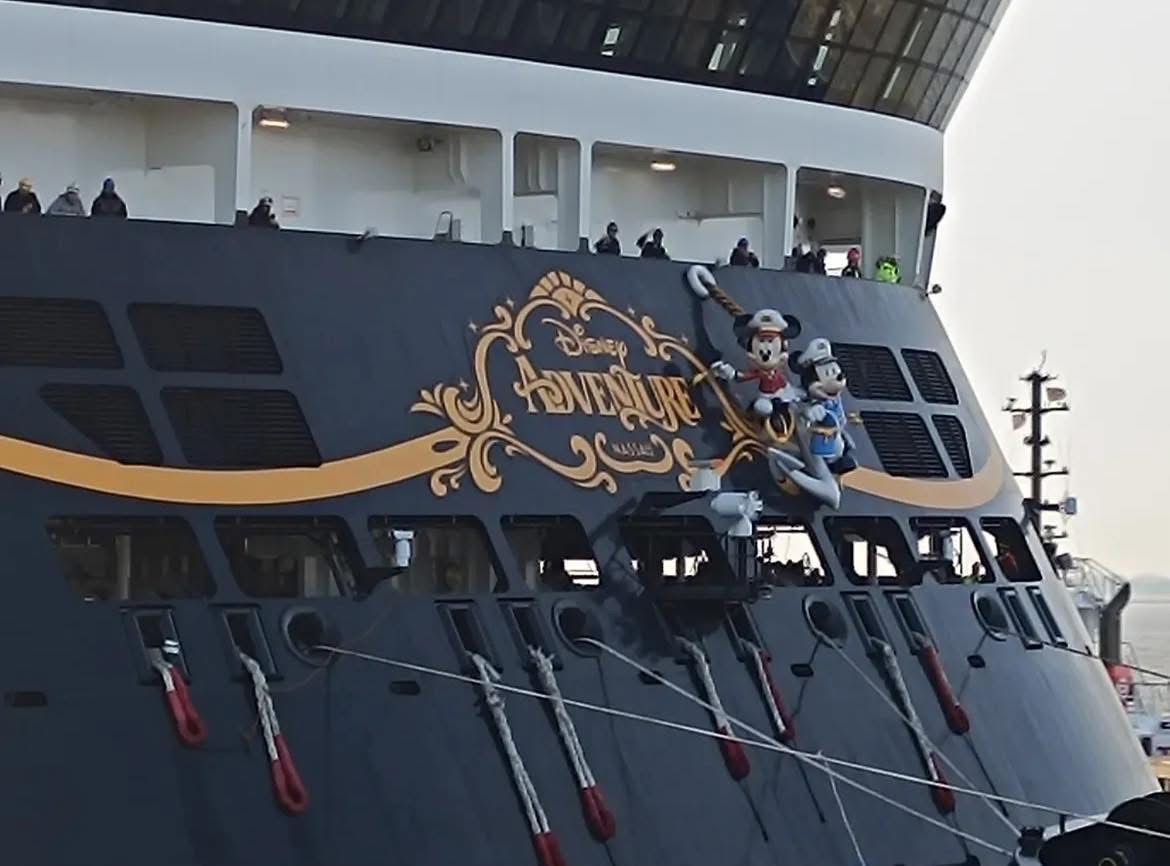
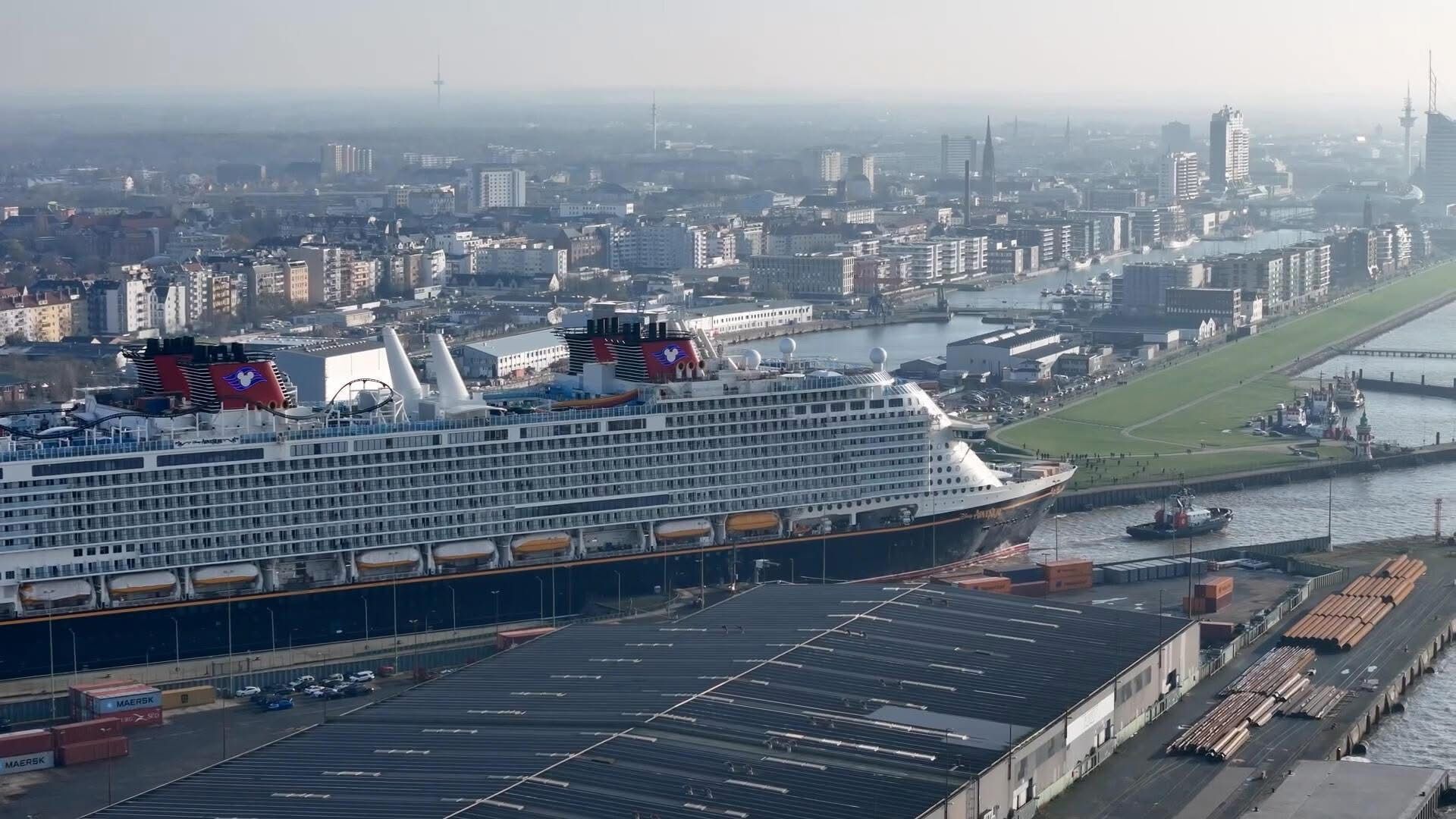
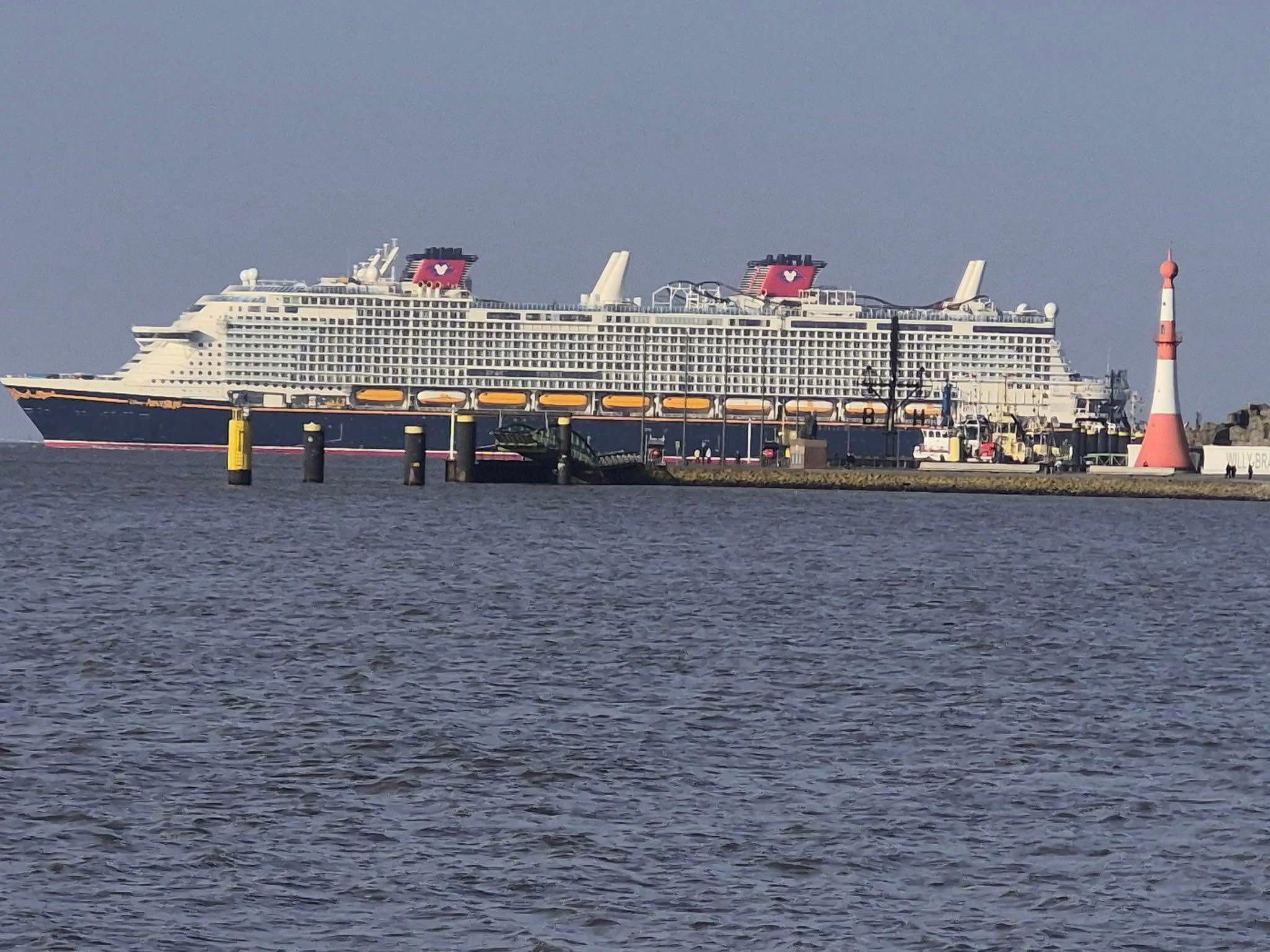
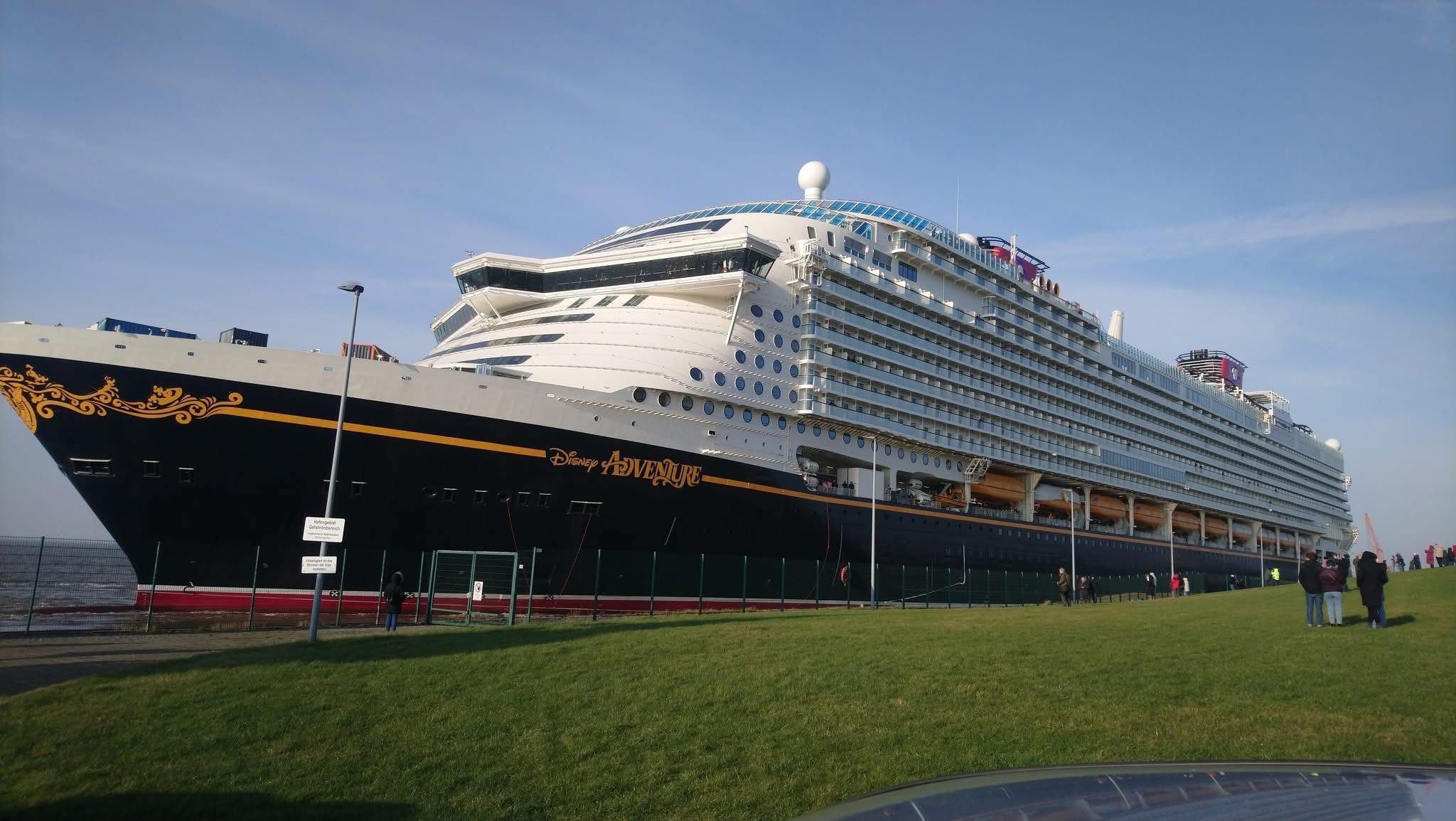
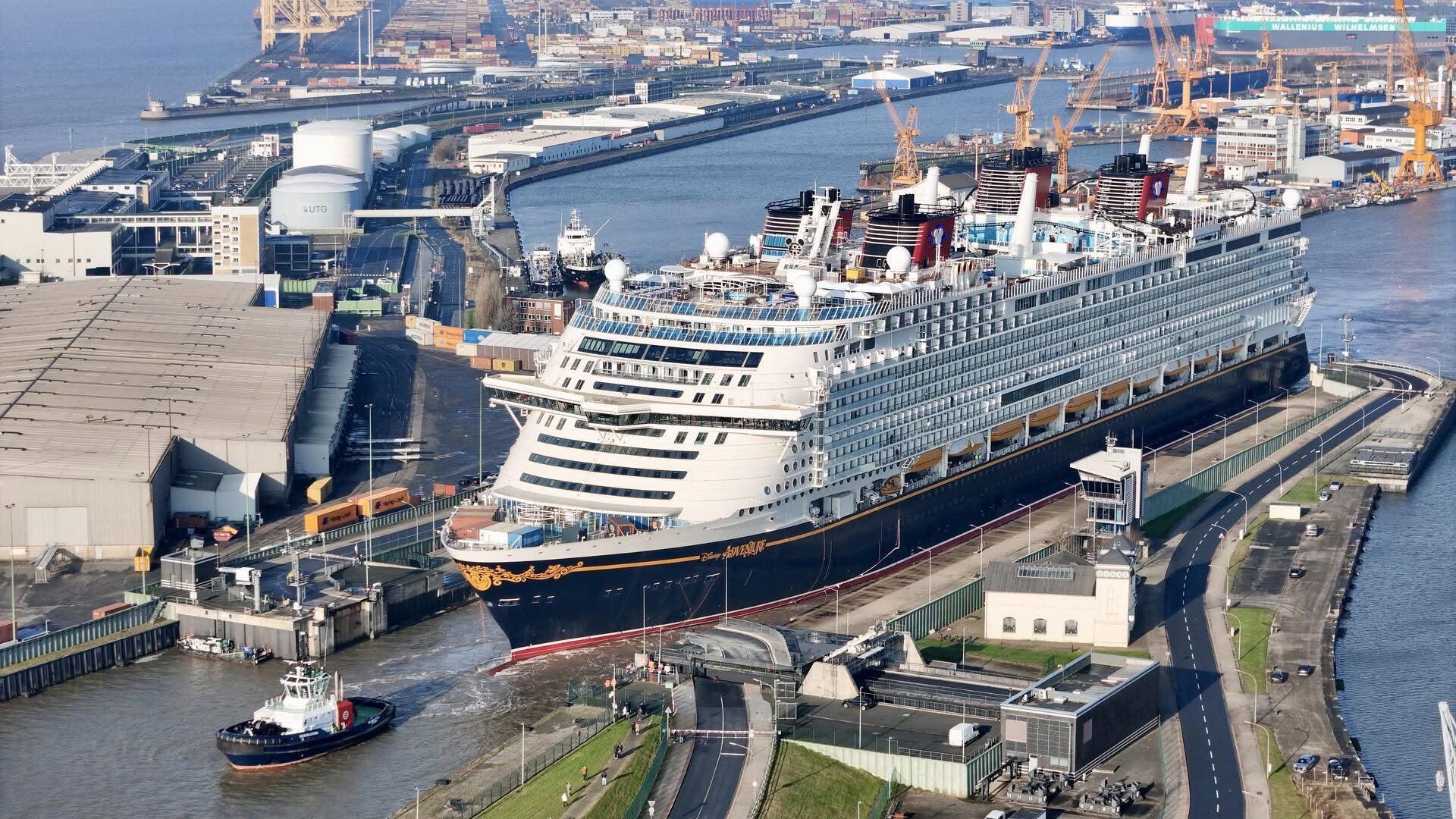
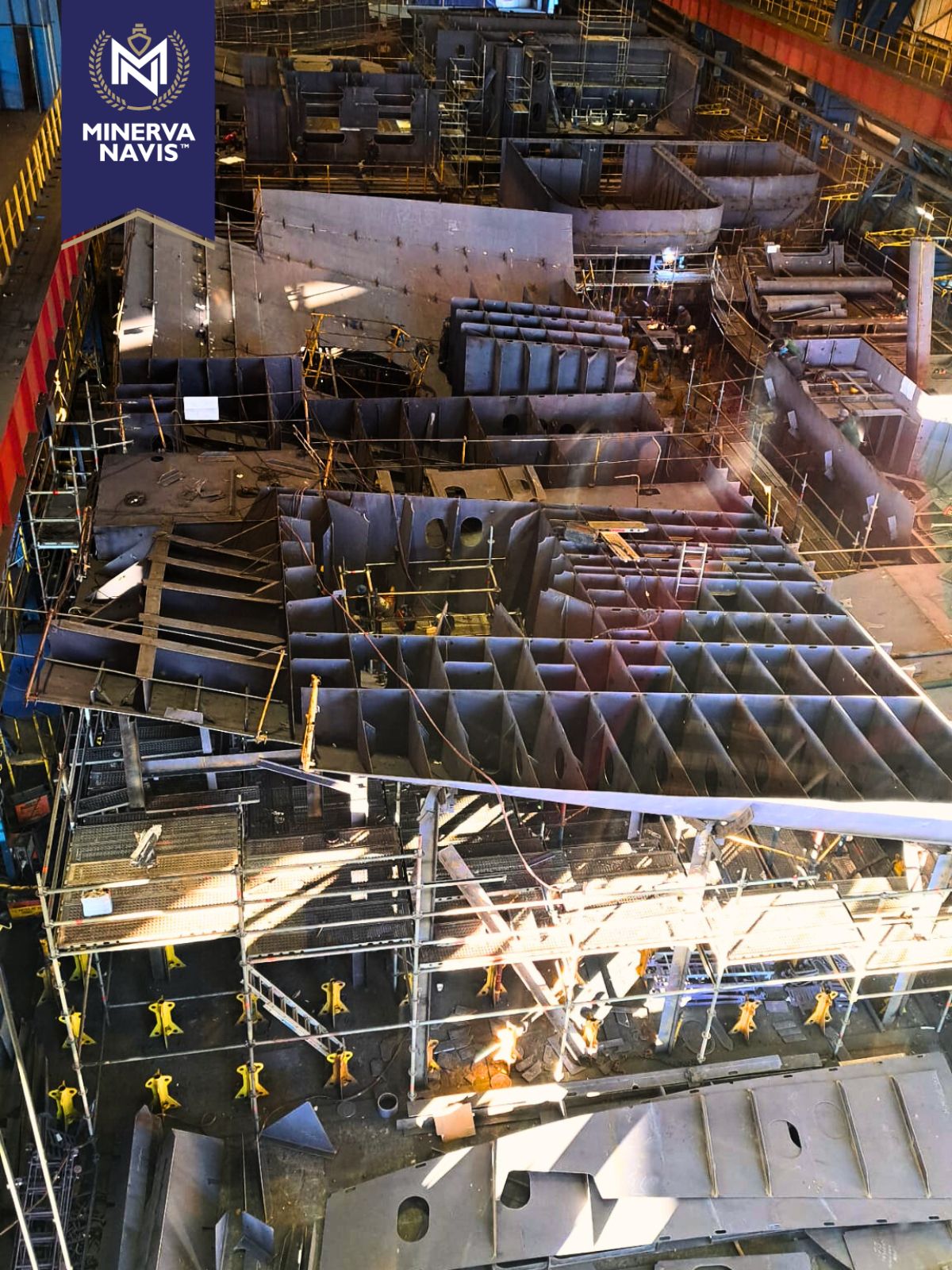
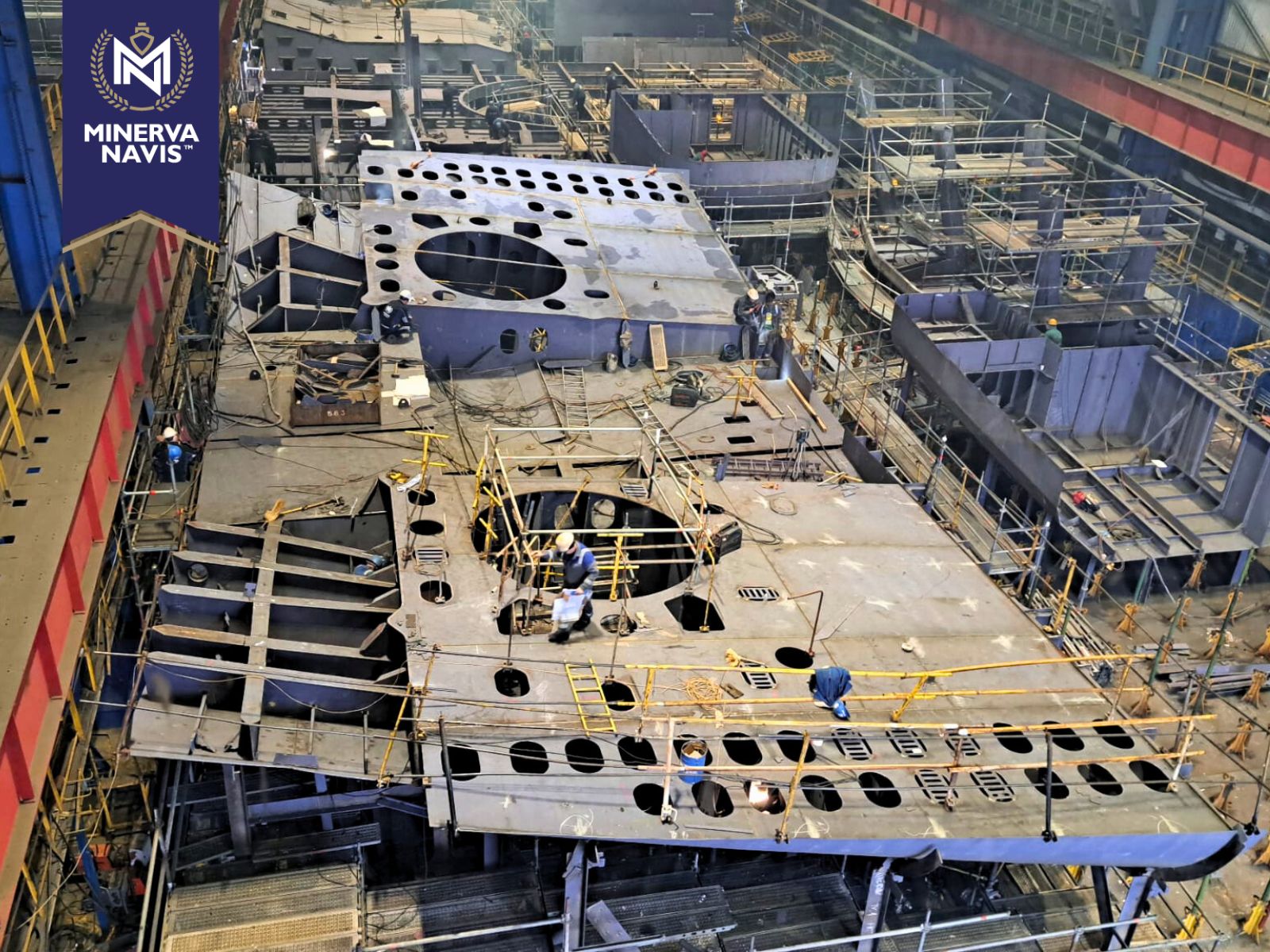
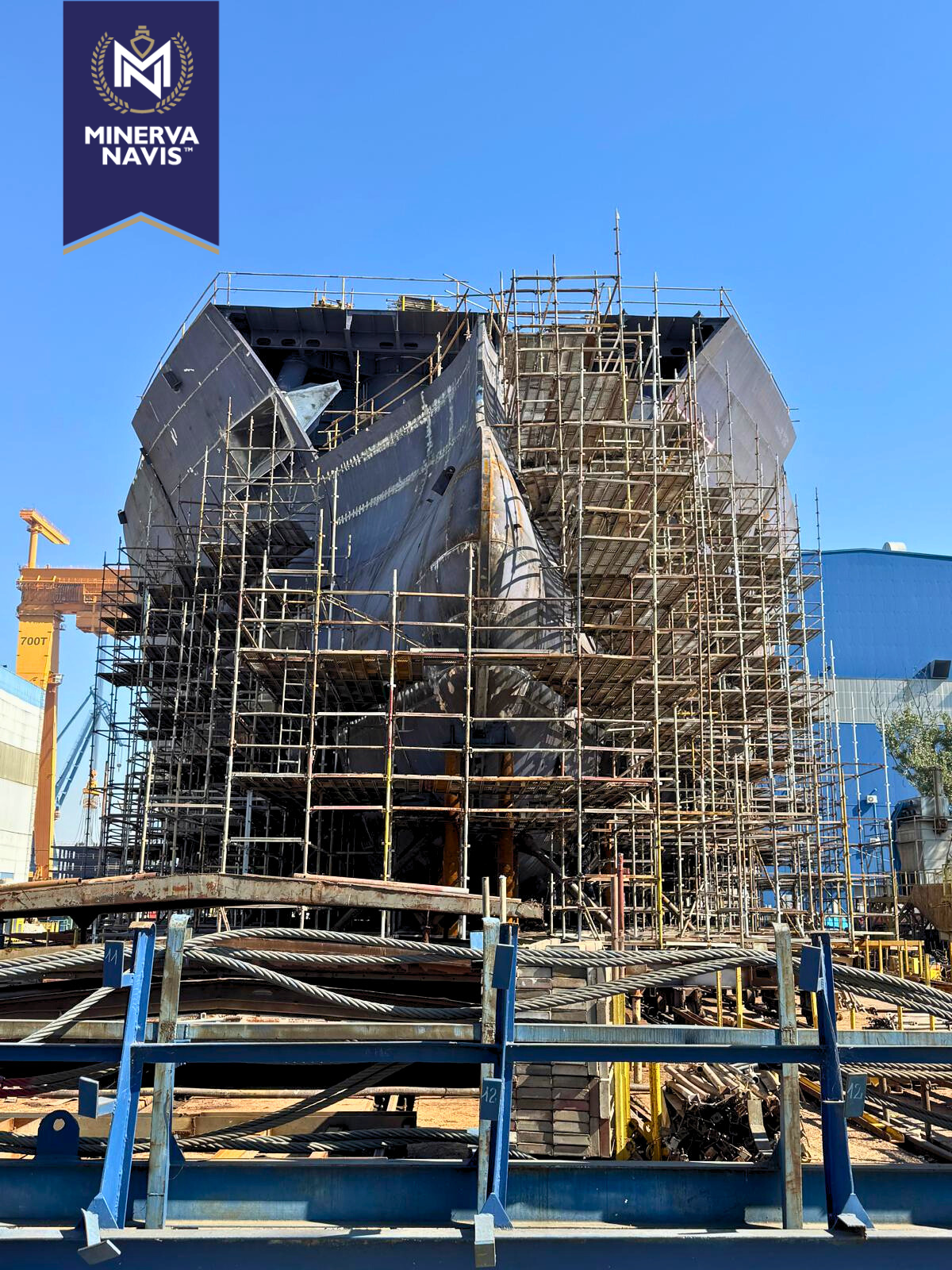
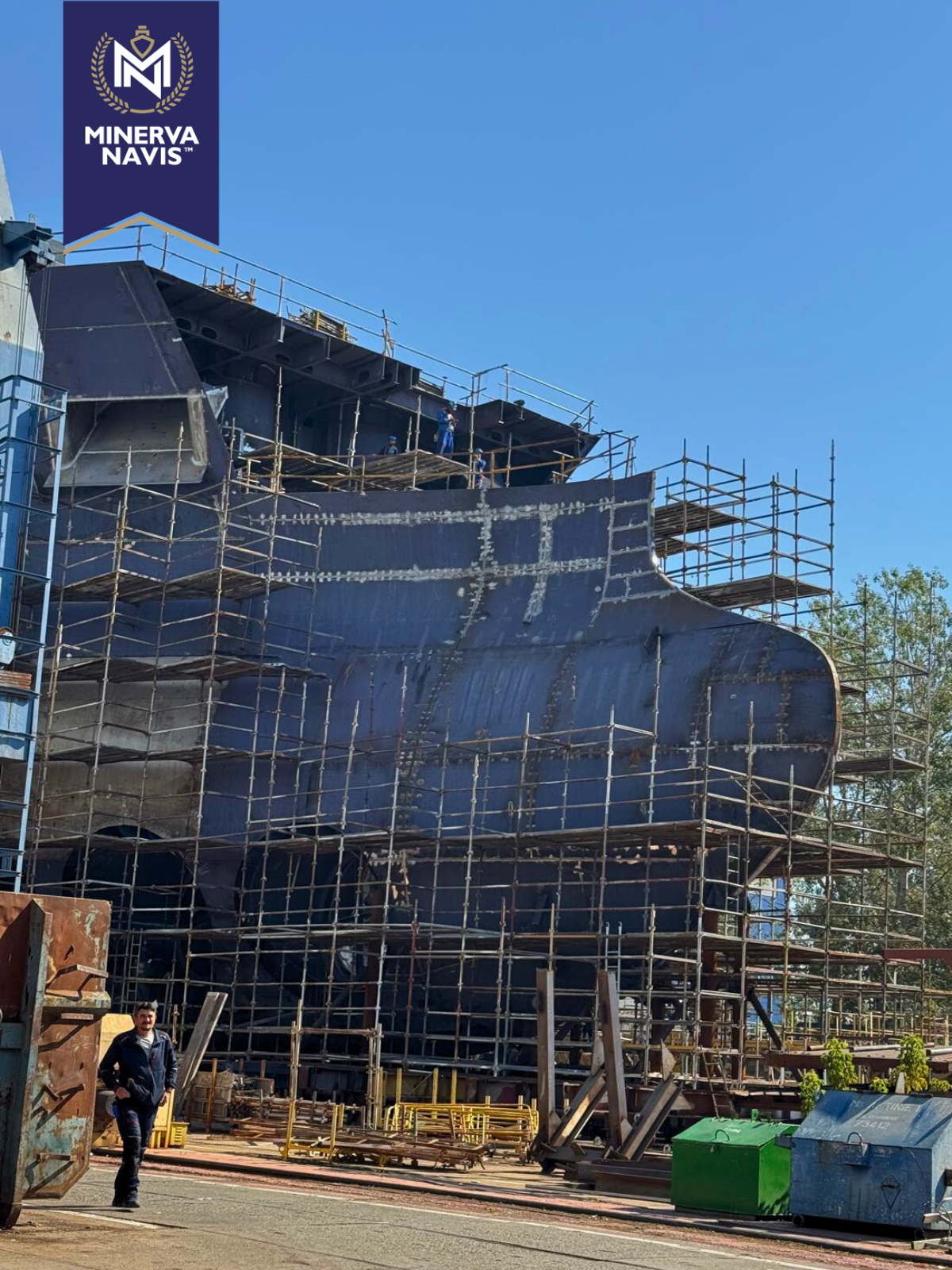
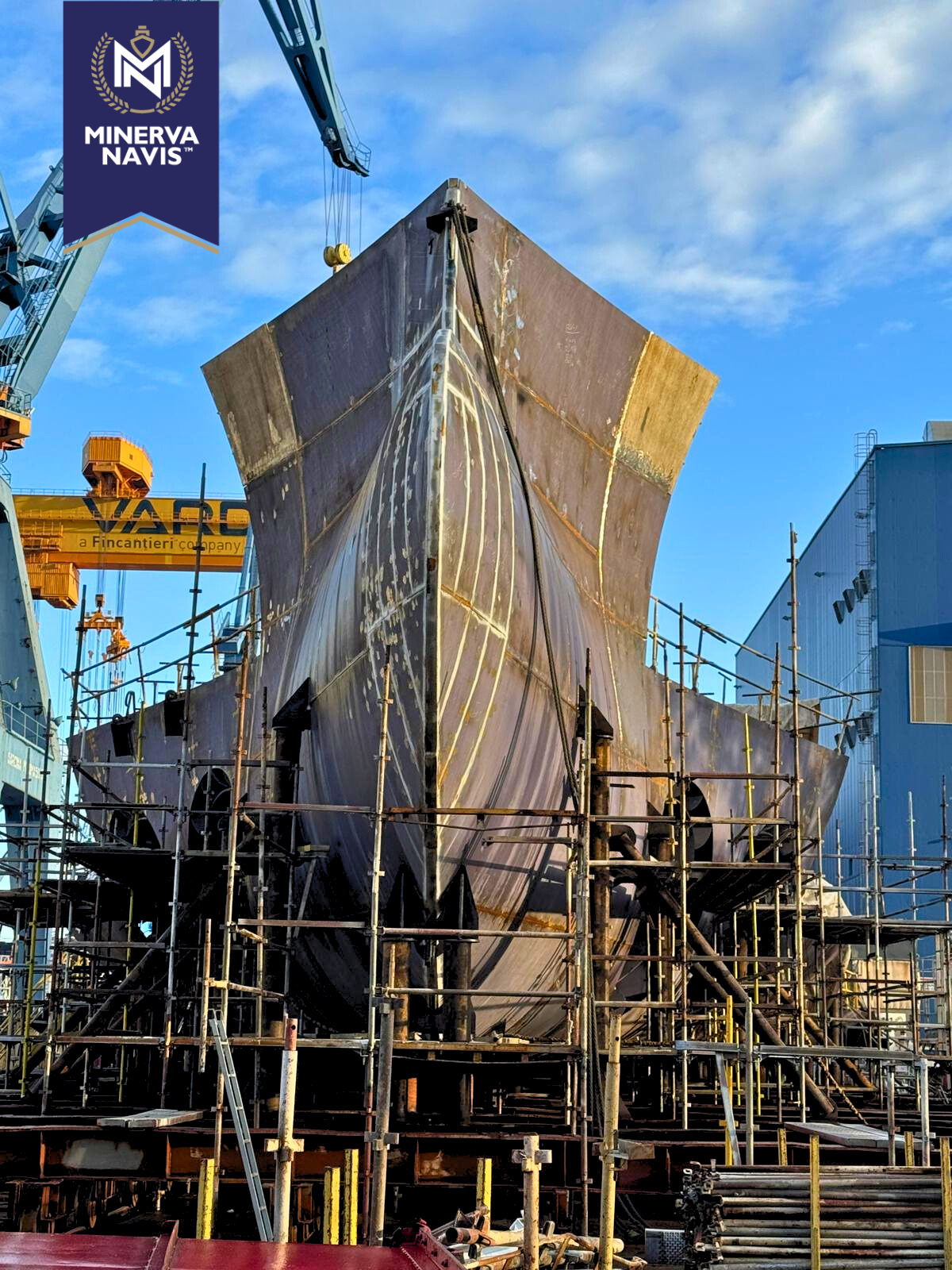
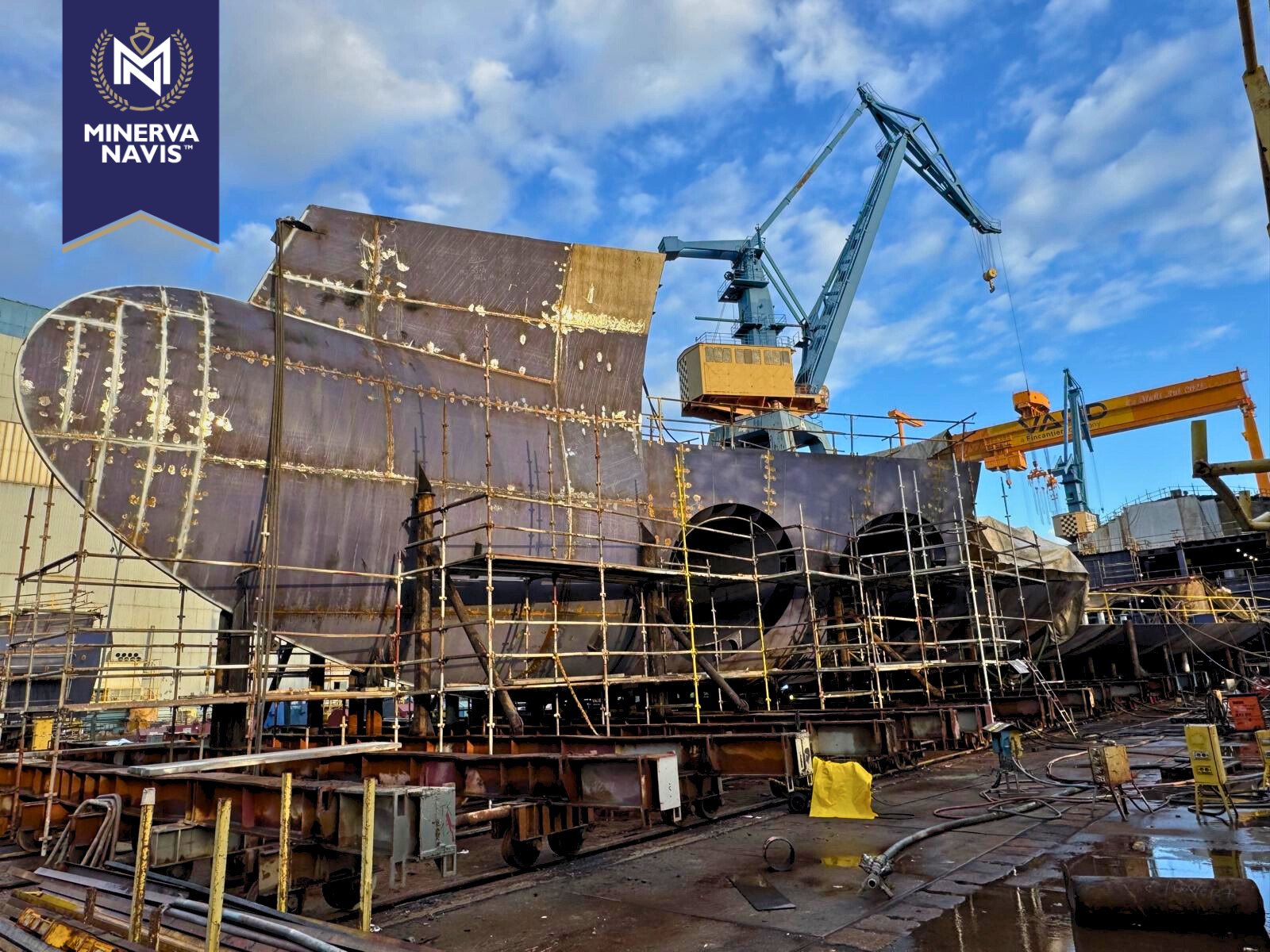
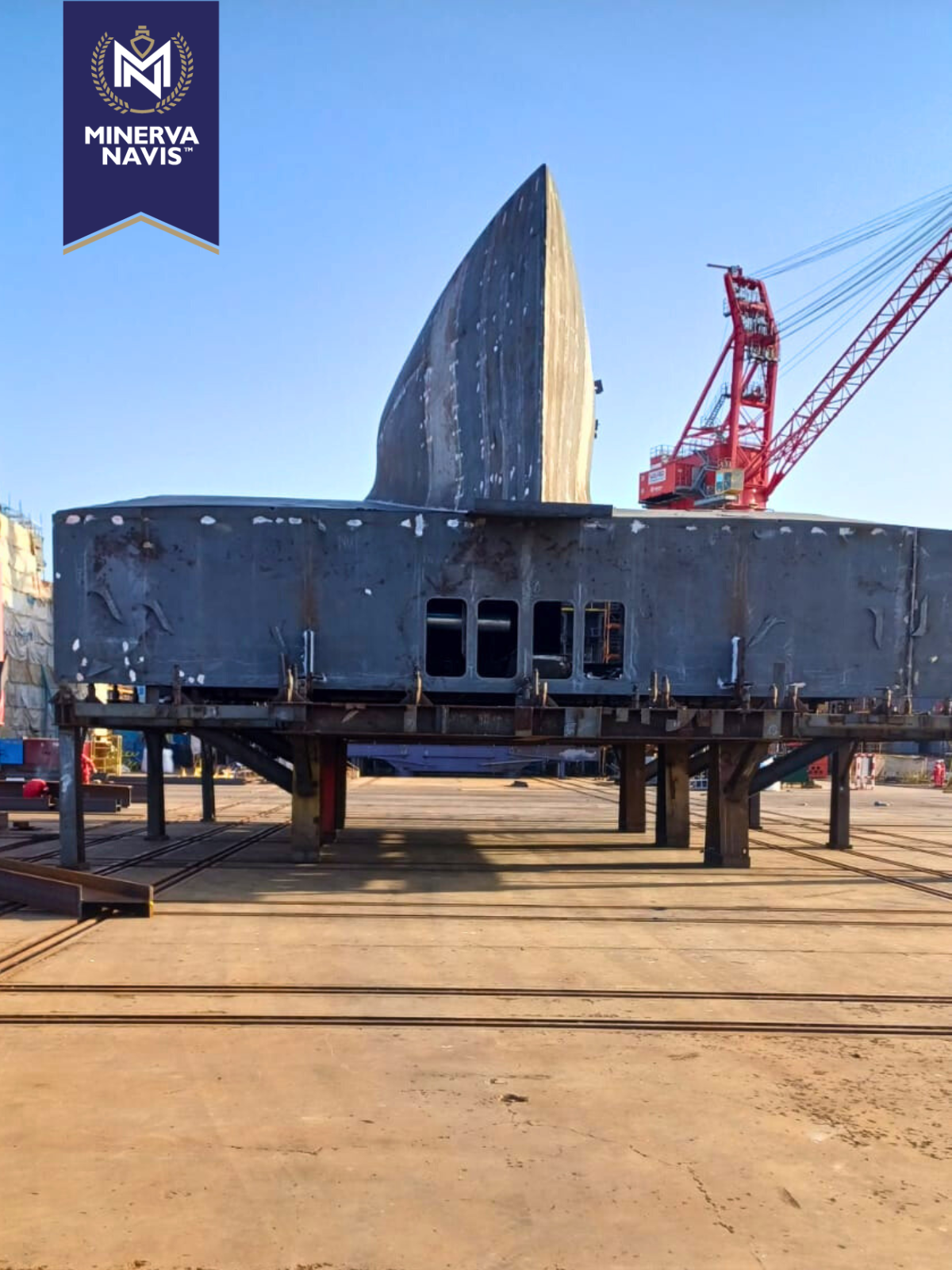
.png)
.png)
